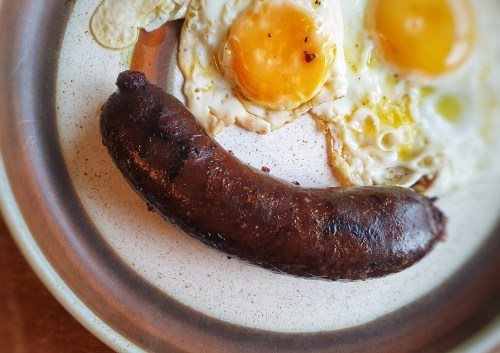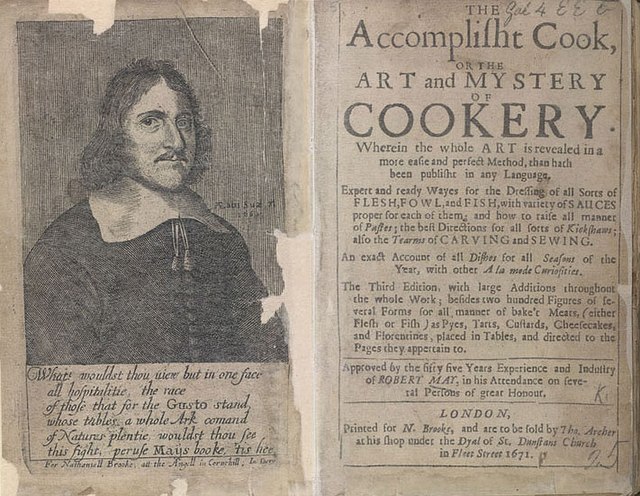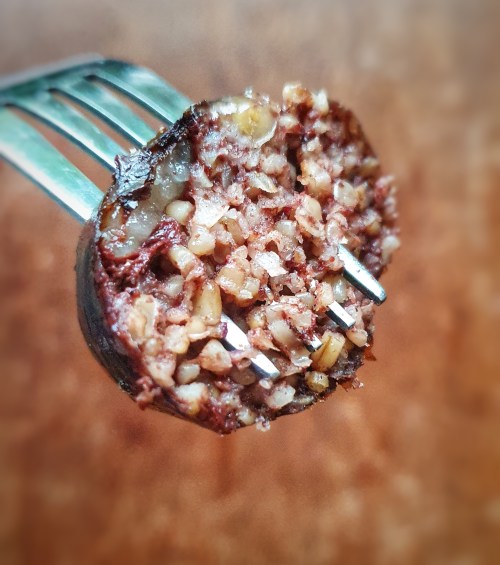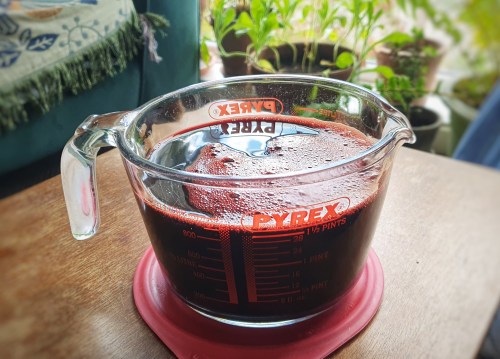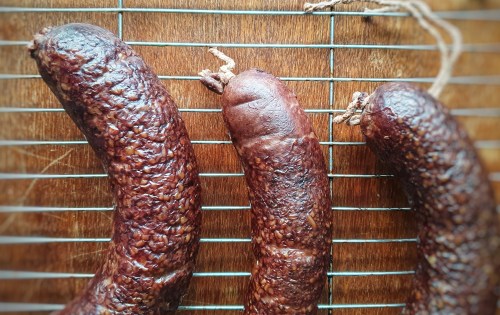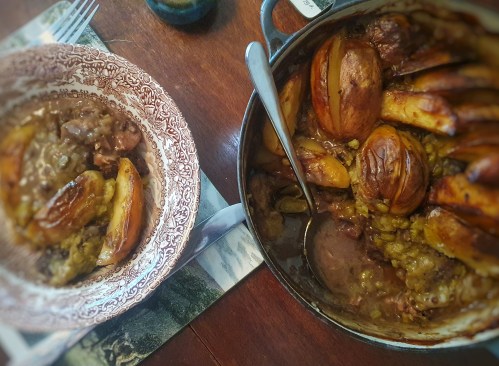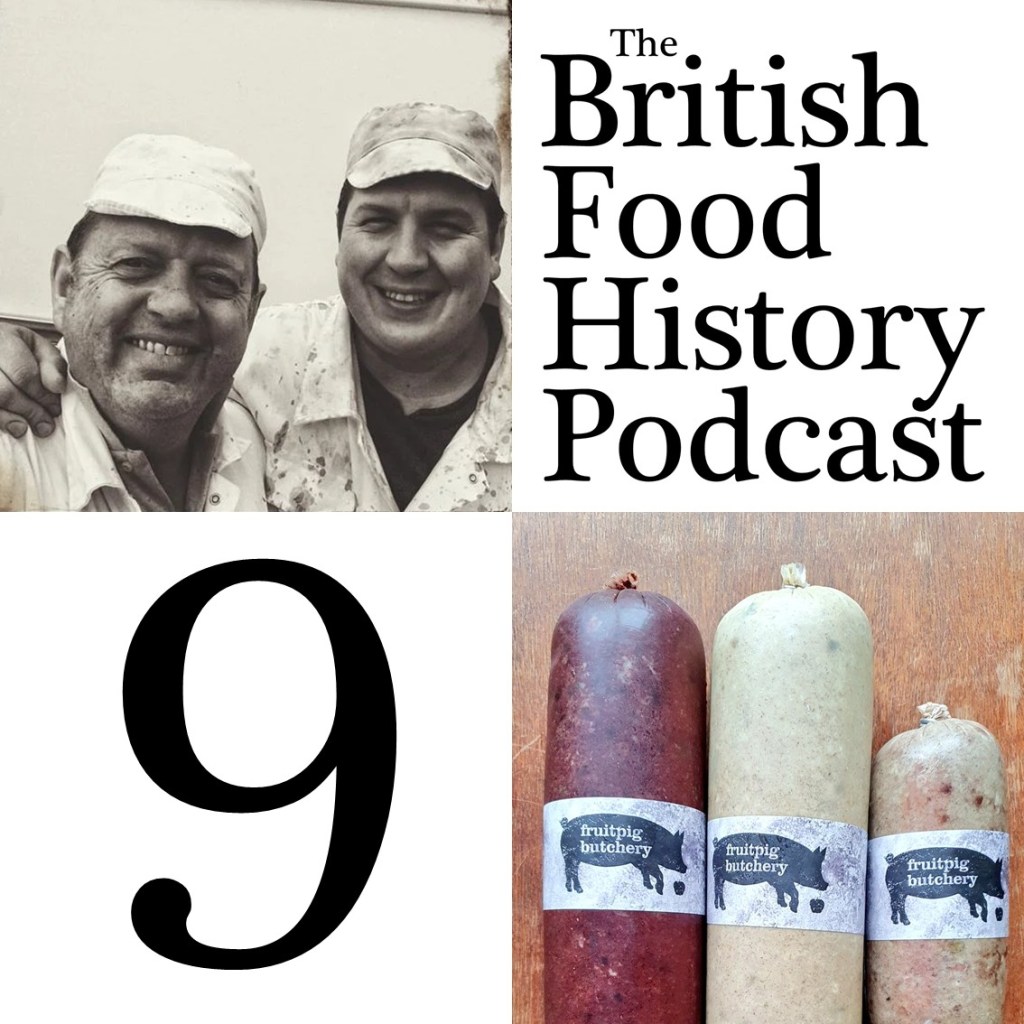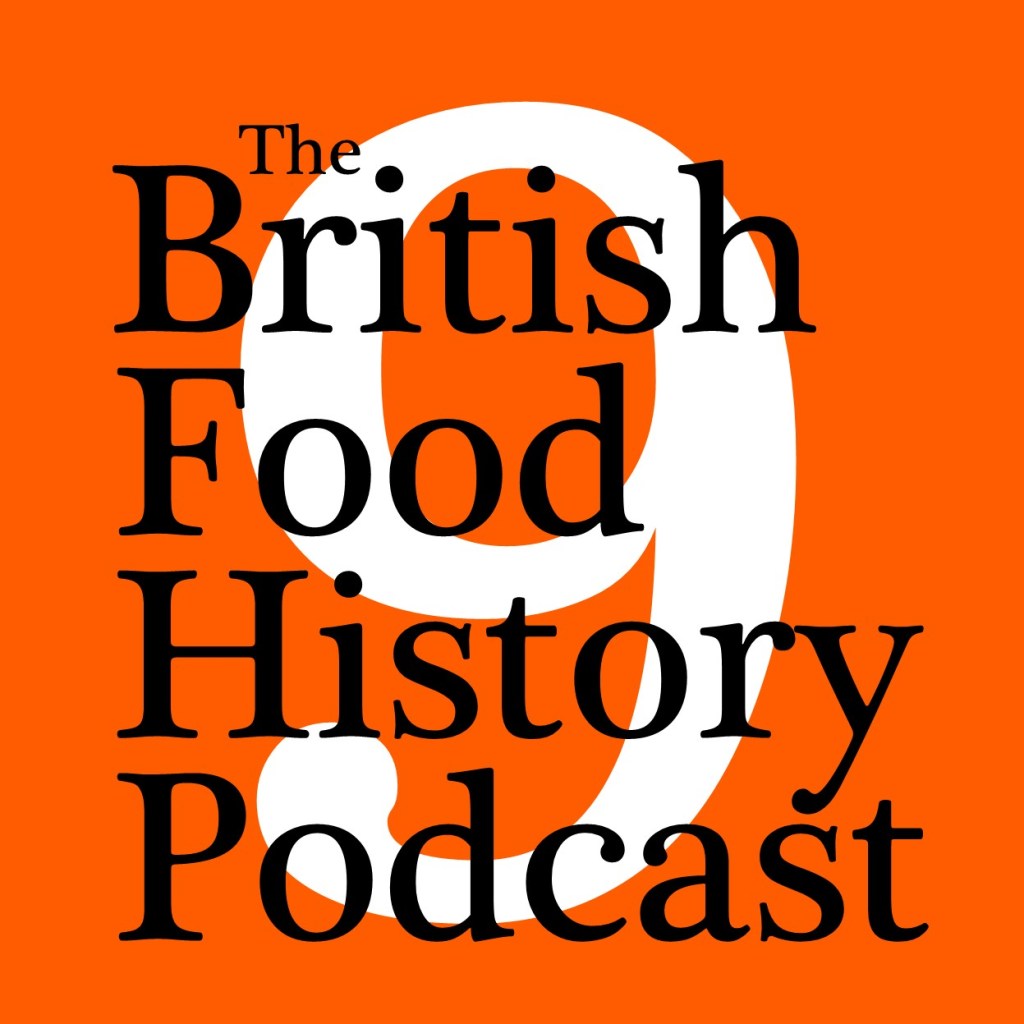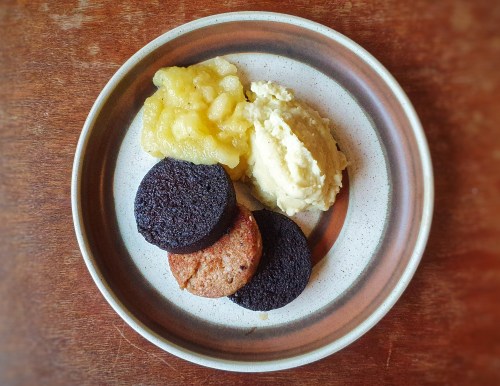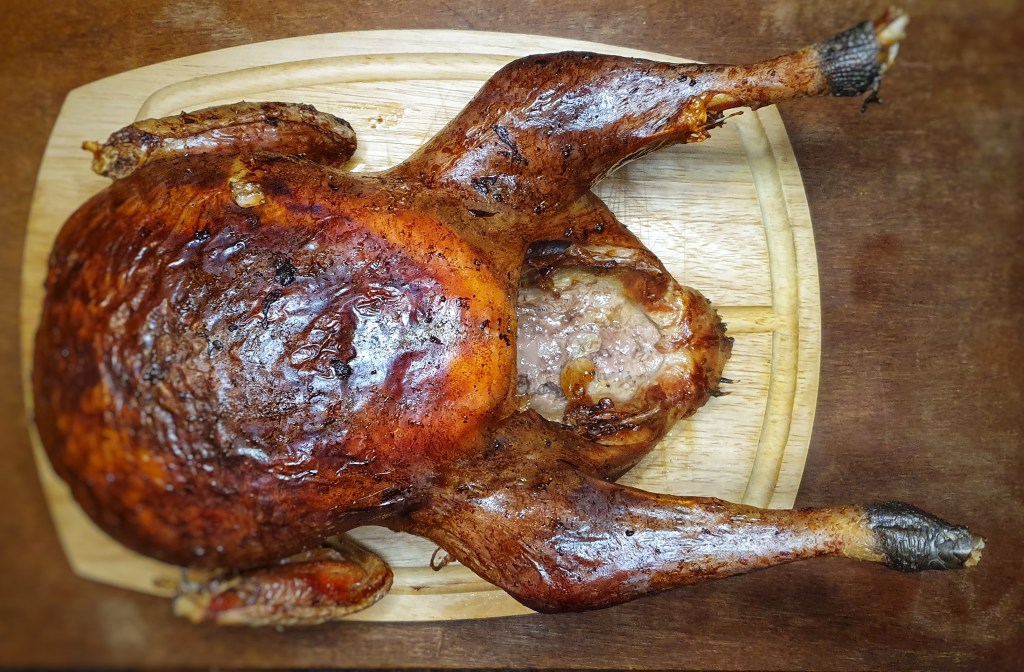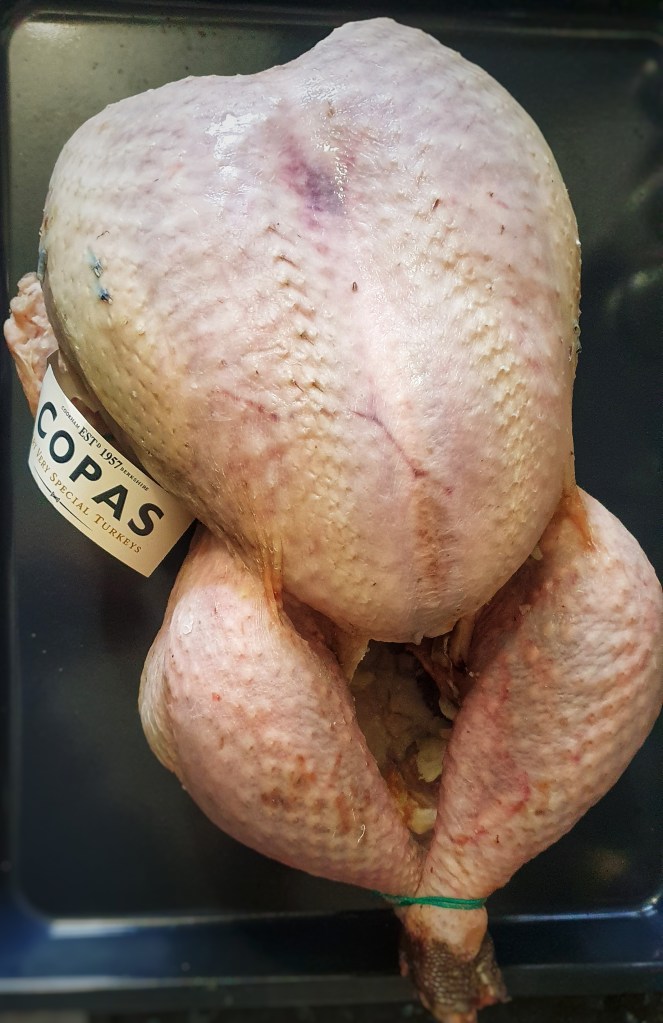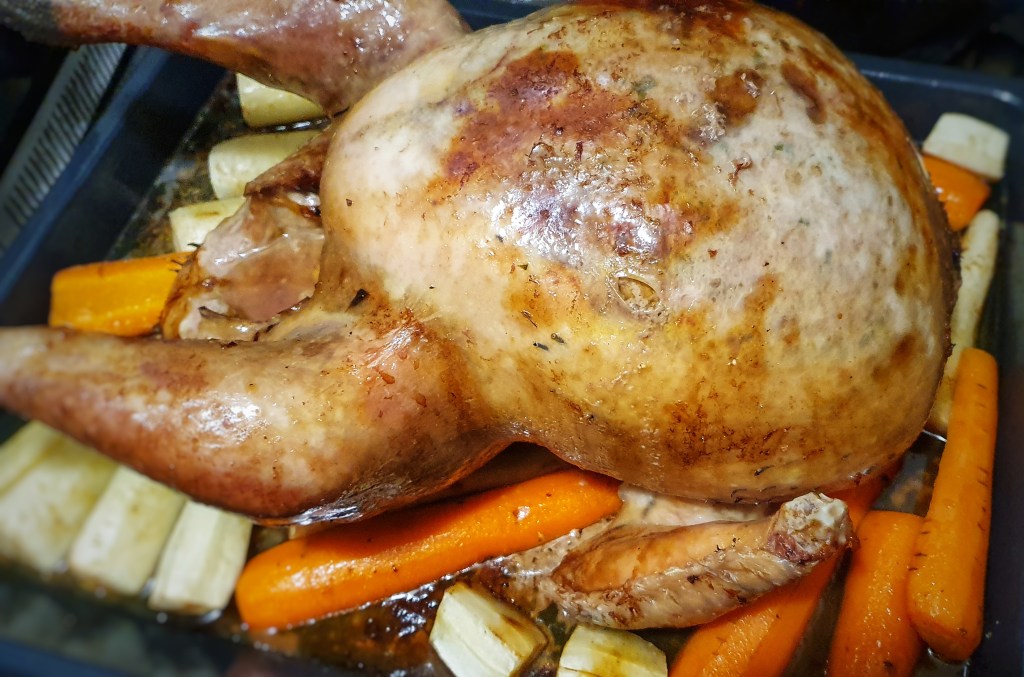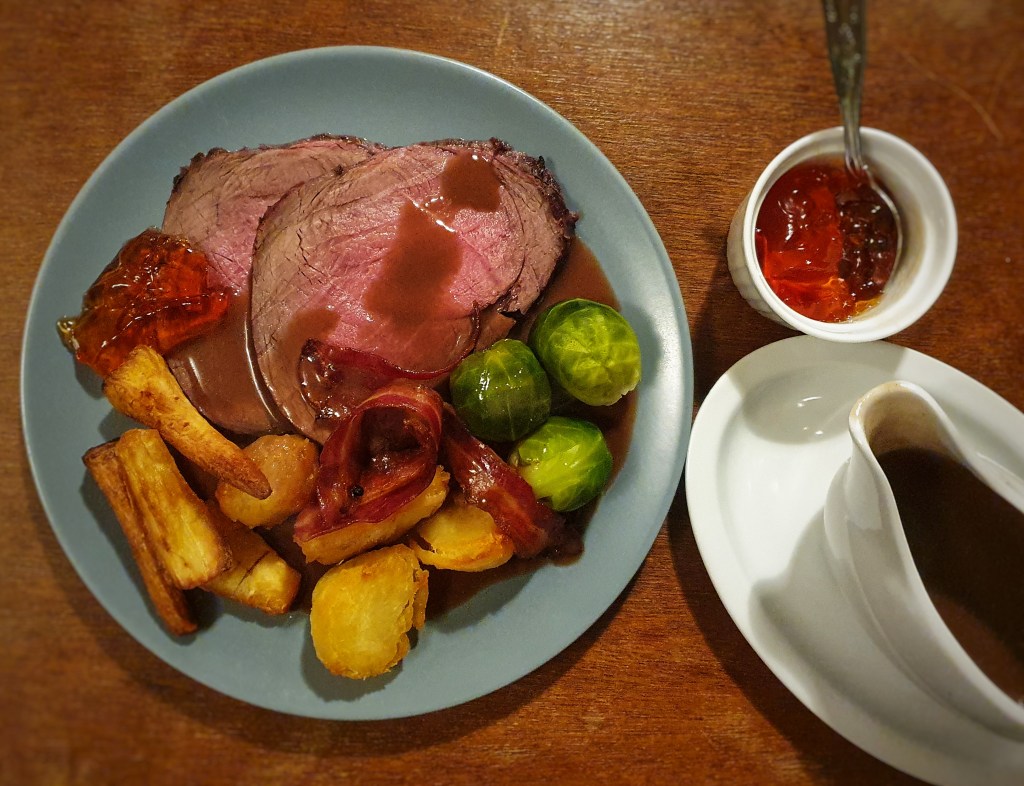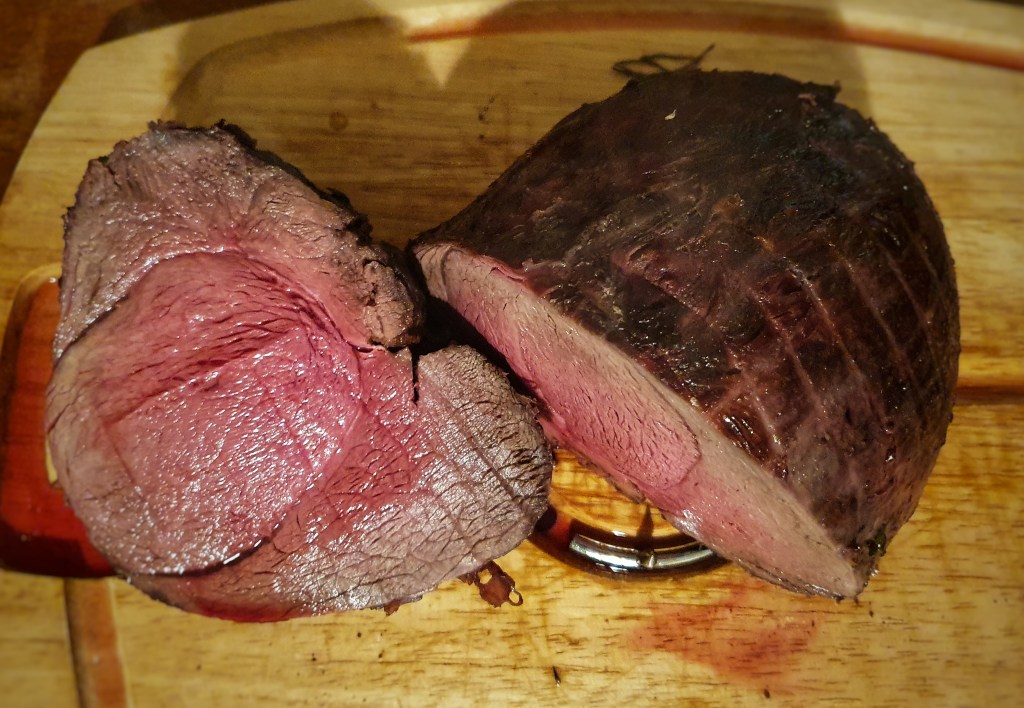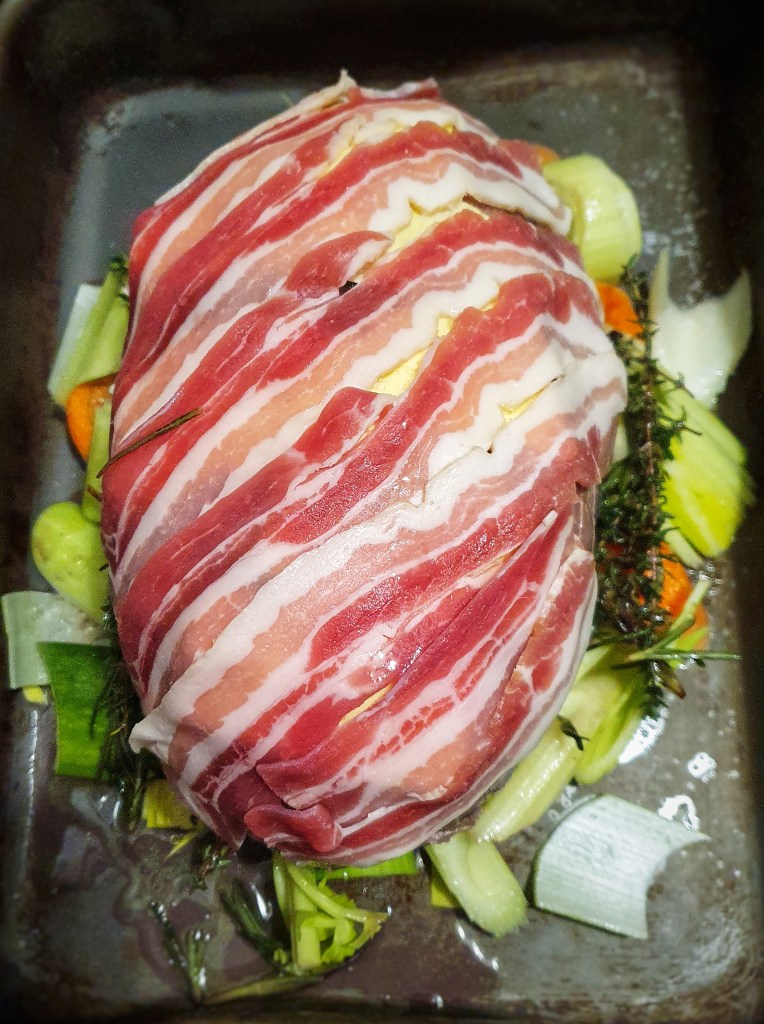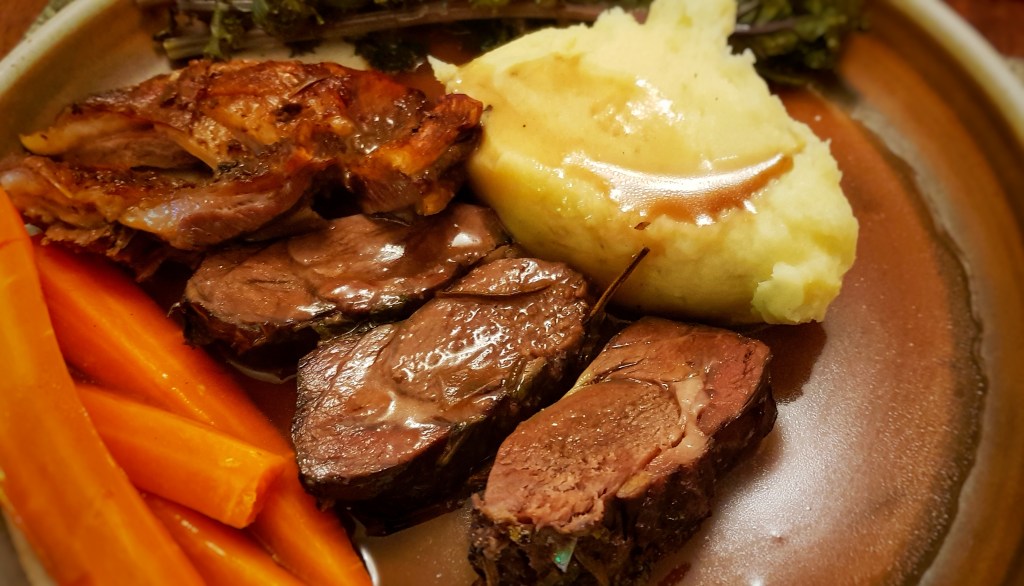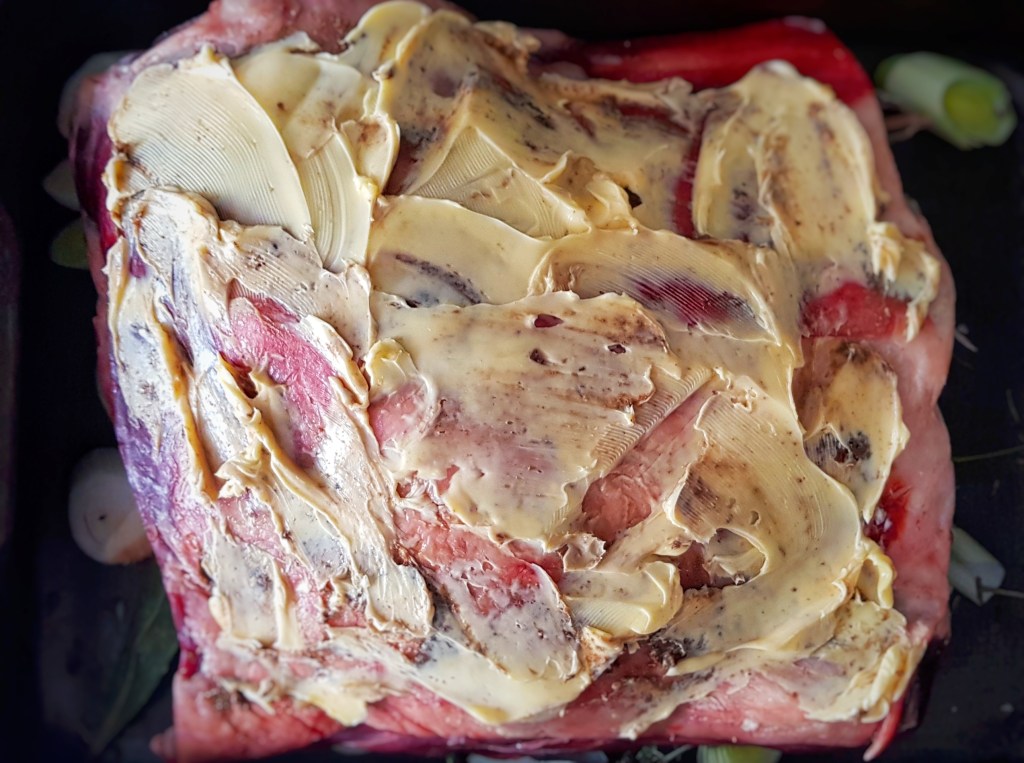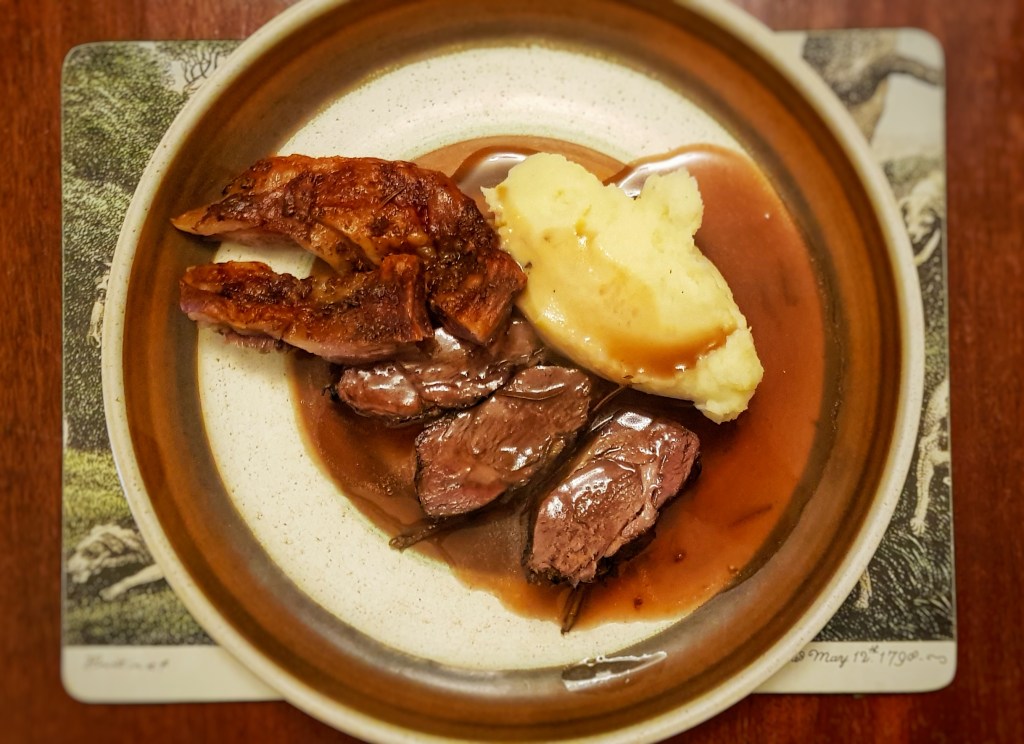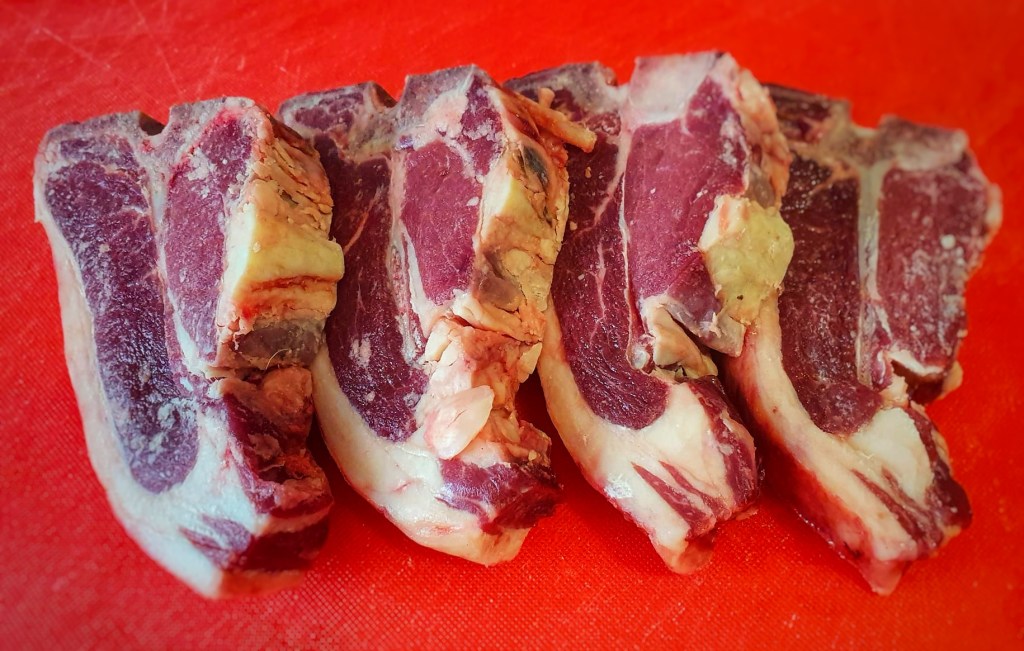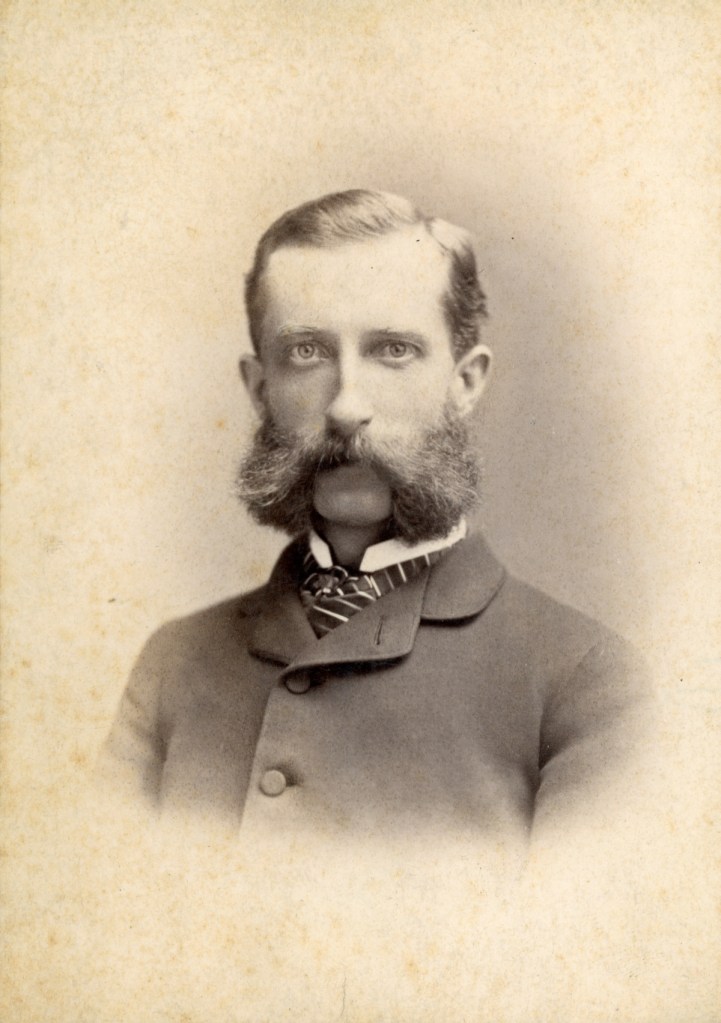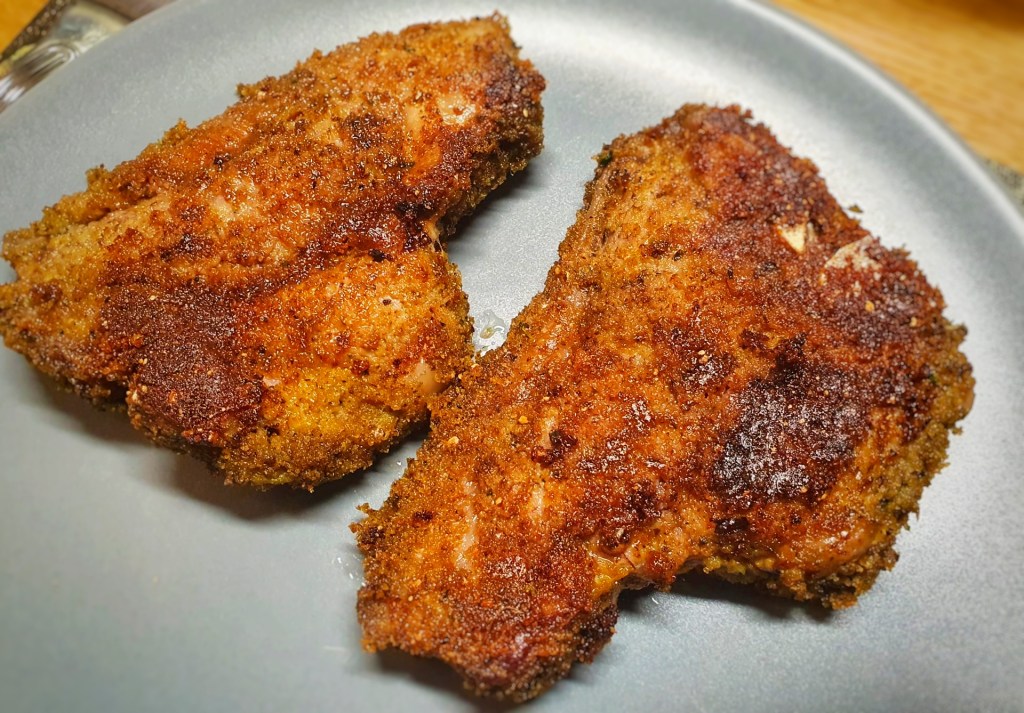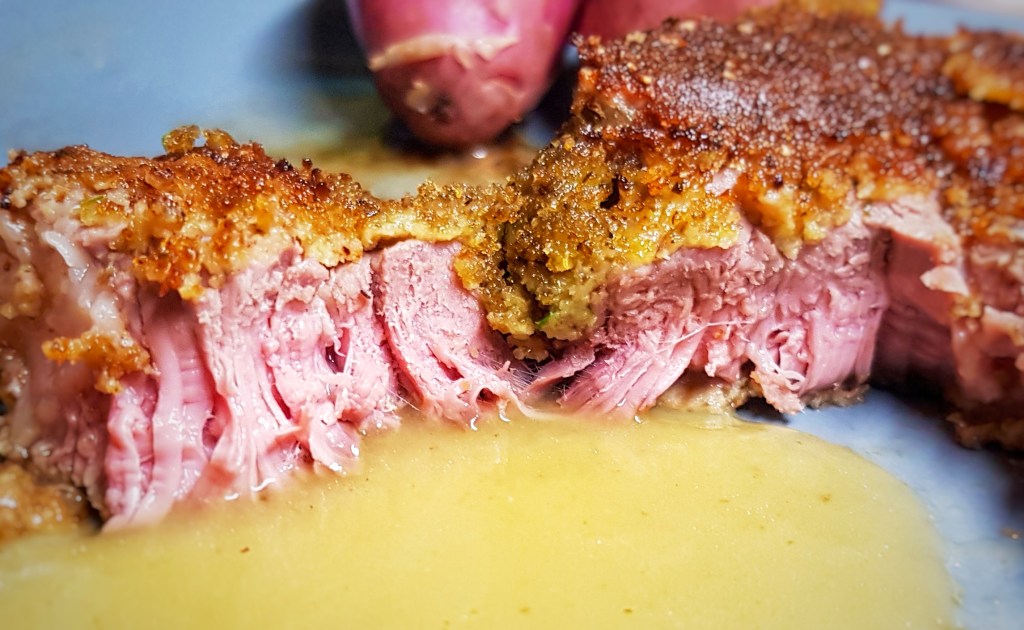Hello! I thought some of you might be interested in a post I just published on the other blog, Neil Cooks Grigson.
Category Archives: Meat
A Recipe for Early Modern Black Puddings
For years now, I have wanted to make my own fresh blood black puddings, but fresh blood is so tricky to get hold of in Britain, I thought I would never get the opportunity. Lucky for me then, that Fruit Pig, who are sponsoring the ninth season of The British Food History Podcast, kindly sent me a litre of pig’s blood. When it came to recipes, I very much had my eye on Early Modern black puddings because they seem so outlandish compared to traditional black puddings of today. On one hand, they are very British, containing oatmeal and/or breadcrumbs and plenty of chopped beef suet. On the other, they are reminiscent of a French boudin noir in that there are lashings of cream and egg yolks.
There are lots of unexpected herbs and spices, too. Thomas Dawson uses sheep’s blood, milk-soaked oats, suet and what we might think of as the constituents of a mixed spice today: nutmeg, mace, black pepper, ginger and cinnamon.[1] Sir Kenelm Digby liked to use chicken blood, cream, almond cream, bone marrow, sugar, salt, rosewater and eggs.[2] Robert May gives us some precise pointers as well as several ways of making black puddings. In one recipe he combines blood and cream in a ratio of 2:1. Sometimes he soaks oats in milk, sometimes blood: ‘Steep great oatmeal in eight pints of warm goose blood, sheeps blood, calves, or lambs, or fawns blood’. He uses a whole range of interesting herbs, including thyme, spinach, parsley, sorrel and strawberry leaves, to name but a few. He also adds ‘Sometimes for variety, Sugar, Currans, &c.’[3] I really want to know what sweet black pudding tastes like!
Using these descriptions as inspiration, I created the recipe below. There was a certain amount of trial-and-error, and whenever I got stuck, I made sure to gain advice from Regula Ysewijn’s Pride and Pudding, Hugh Fearnley-Whittingstall’s The River Cottage Cookbook and Fergus Henderson’s The Complete Nose to Tail.[4]
I learned a great deal making them – the most important lesson being just how skilled one must be to make these sorts of puddings frequently and in large amounts. It made me appreciate even more the hard work of our forebears and Fruit Pig!
I was really surprised with how well the puddings turned out, and I would certainly recommend giving them a go. I made one batch with sugar and currants and one without. You might be surprised to hear that the sweet one was really quite delicious. I fried my savoury puddings and served them with fried eggs atop some sourdough toast. They tasted rich and were a cross between a black pudding and haggis. I’ll let you know how I served the sweet black puddings.
There are just a couple of things I would have done differently: my main issue was that the butcher gave me pigs’ casings which were not suitable for these black puddings – the nubbly pieces of oat tore through them easily, and the skin burst under their own weight at times. I would therefore recommend beef casings or simply baking them in the oven in loaf tins, or maybe even frying up blood pancakes as suggested by Regula Ysewijn![5]
If you can, support the podcast and blogs by becoming a £3 monthly subscriber, and unlock lots of premium content, including bonus blog posts and recipes, access to the easter eggs and the secret podcast, or treat me to a one-off virtual pint or coffee: click here.
Recipe
Makes approximately 12 x 20 cm black puddings if made in pork casings, and 6 x 20 cm puddings if made in beef casings.
600 g pinhead oats
Milk (see recipe)
1 tsp fennel seeds
½ tsp cloves
½ tsp black peppercorns
3 blades of mace
1 ½ tsp dried, mixed herbs
2 tsp salt
900 ml fresh pig’s blood (or reconstituted dried blood)
600 ml double cream
200 g chopped beef suet
2 whole eggs, beaten
140 g currants (optional)
320 g sugar (optional)
Natural pork or beef skins, soaked in water overnight (optional, see recipe)
The day before you want to make your puddings, place the oats in a bowl or large jug and pour in enough milk to just cover them. Place in the fridge overnight. Grind the spices and mix in the dried herbs and salt.
Next day, place all of the ingredients (aside from the casings, if using) in a large mixing bowl. Combine and allow everything to mingle, dissolve and absorb; around an hour – or more if you have the time.[6]

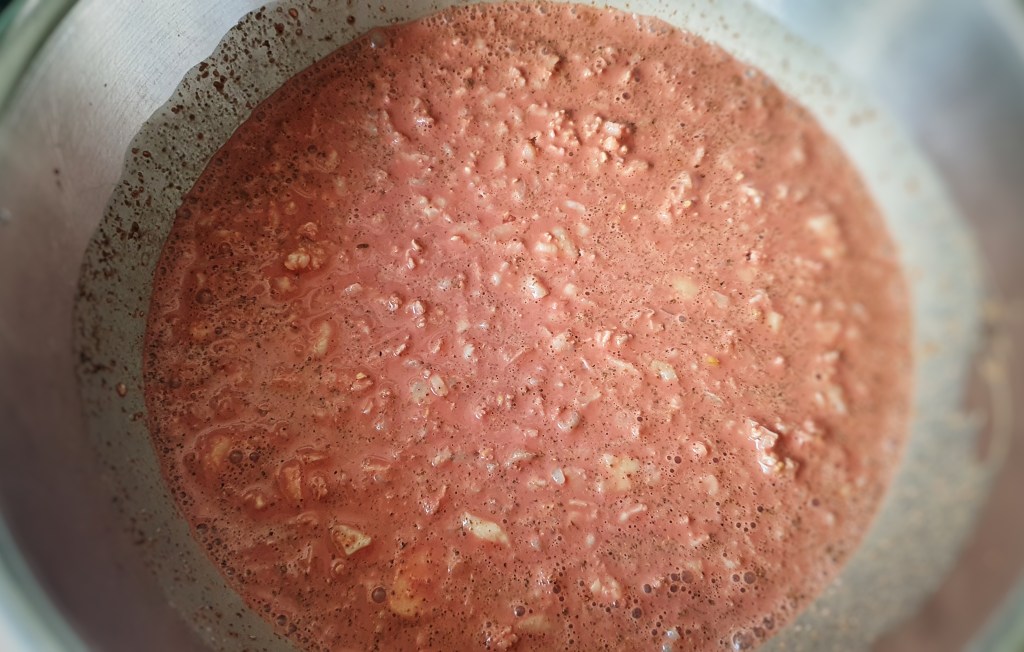

Once everything has had the chance to macerate and absorb, it is time to assemble the puddings. I used my sausage stuffer funnel from the Kitchen Aid and attached a length of pork casing onto it, then secured it with some string and knotted the end. Then I set about filling the casings, a spoon at a time, letting the skins naturally fill and fall into a bowl. Then I tied a link off with some string, making sure the casing wasn’t full and there were no obvious air bubbles. The lengths of the puddings were around 20 cm – though I wasn’t very consistent. In retrospect, I would recommend using beef casings tied to a wide-mouthed jam funnel, much easier to fill and no constant tearing.
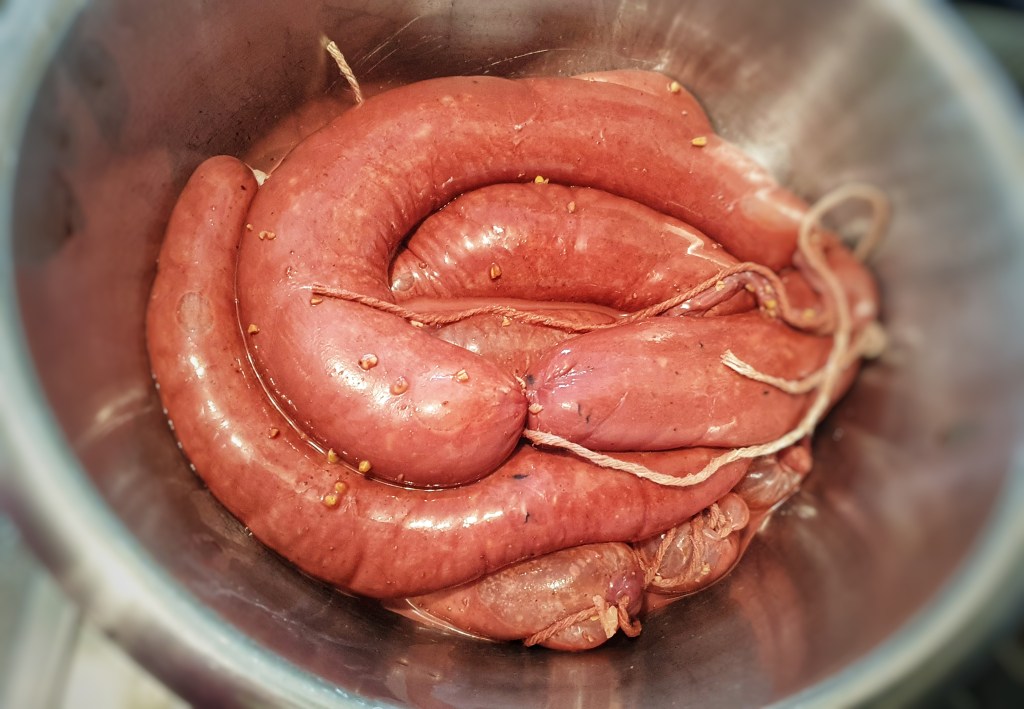
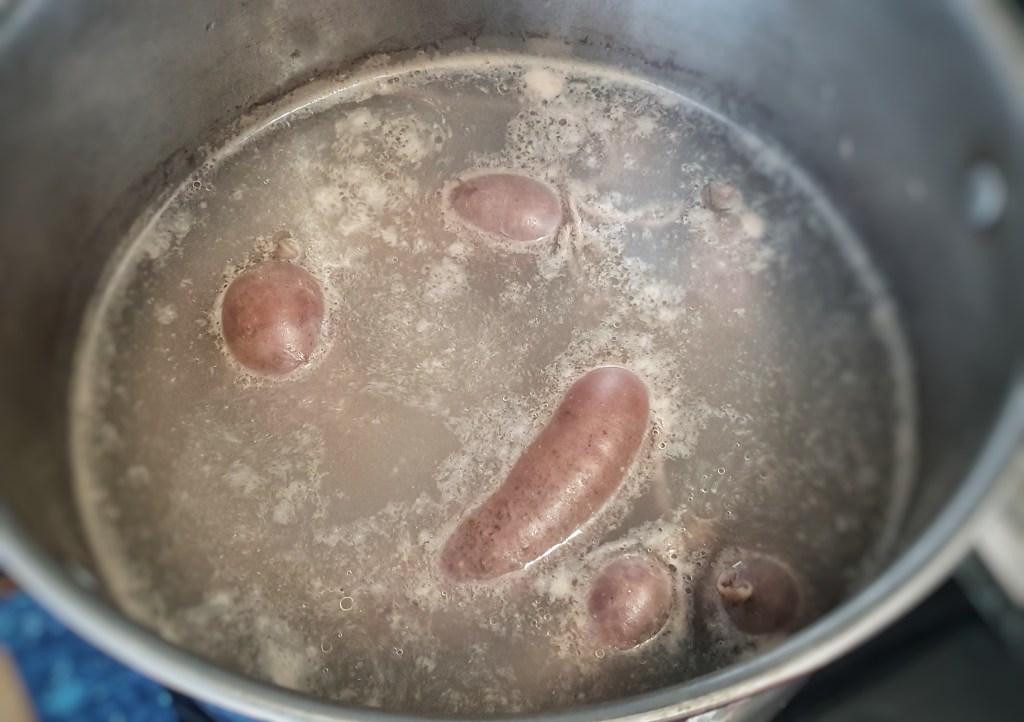
Once all of the mixture is used up, get a large pot of water to a good simmer and gingerly plop them in a few at a time. Three was a good number. Keep the water at a gentle simmer and arm yourself with a pin and pop any bubbles that appear in the cooking puds, lest they burst. They will take around 20 minutes to cook, and you must watch them like a hawk, pin poised and ready to pop. You can tell they are done when the liquid that comes out of a freshly-pricked pudding is clear. If using beef casings, they will take 30 to 35 minutes to cook.
Carefully remove the puddings and either hang them up or lay them on a cooling rack to dry for a few hours before placing them in the refrigerator.
You can avoid all of this faff by baking the mixture in large loaf tins sat in a bain-marie for around 1½ hours at 160°C.[7]
Notes
[1] Dawson, T. (1596). The Good Housewife’s Jewel (1996 Edition). Southover Press.
[2] Digby, K. (1669). The Closet of Sir Kenelm Digby Opened (1997 reprint) (J. Stevenson & P. Davidson, Eds.). Prospect Books.
[3] May, R. (2012). The Accomplisht Cook (1660/85) (A. Davidson, M. Bell, & T. Jaine, Eds.; 1685th ed.). Prospect Books.
[4] Fearnley-Whittingstall, H. (2001). The River Cottage Cookbook. Collins; Henderson, F. (2012). The Complete Nose to Tail: A Kind of British Cooking. Bloomsbury; Ysewijn, R. (2015). Pride and Pudding: The History of British Puddings Savoury and Sweet. Murdoch Books.
[5] Ysewijn (2015)
[6] Note: Looking back on these initial stages, it would have been much better to soak the oats in the blood overnight, mix everything together in the morning, let everything meld and mingle for a couple of hours, and then add enough milk to make a mixture of a spoonable porridge consistency. We live and learn.
[7] Note: I haven’t tested this method; these instructions have been extrapolated from the Fergus Henderson recipe for blood cake in Henderson (2012).
Cumbrian Tatie Pot (aka Cumberland or Westmorland Hotpot)
In my last post I launched the ninth season of The British Food History Podcast with an episode about Black and White Pudding with Matthew Cockin and Grant Harper (aka Fruit Pig). Not only are they the only remaining craft producer of fresh blood black puddings in Britain, but they are very kindly sponsoring this season of the podcast. Their puddings are exceptional, and Matthew and Grant are very kindly giving readers of the blog and listeners of the podcast 10% off at their online shop (www.fruitpig.co.uk) with the offer code Foodhis, so if you can please support them – if we don’t use producers like Fruit Pig, we will lose them, and that would be a terrible shame. It’s also worth checking with your local butcher – my nearest traditional butcher, Littlewood’s in Heaton Moor, Stockport, the very place where I bought the meat for today’s recipe, stock them – so perhaps yours does too (or you could suggest they do if they don’t!). Have a listen to the episode, if you haven’t already:
Now, I reckon the vast majority of black pudding eaters enjoy theirs as part of a fried breakfast, but I think we need to remember that black puddings can be eaten for any meal, and in the last post I detailed the old traditional way of eating them with mashed potato and apple sauce. Today I am going one better with this delicious and warming Cumbrian Tatie Pot, a hotpot made of lamb, beef and black pudding, pulses and onions, topped not with nice, neat round slices of potato like a Lancashire hotpot, but quartered floury potatoes.[1] It is important that the cheaper, tougher cuts of beef shin and lamb neck are used, and that the hotpot should be cooked long and slow.
The result is a rich and unctuous hotpot that sticks to your ribs and serves plenty of people; it was on the menu at The Buttery in the first year it was open, and it was very popular.[2] Well-flavoured meat cuts like shin and neck require a similarly good-flavoured black pudding like those made by Fruit Pig.
I first heard about this rather decadent one-pot dish from Jane Grigson in her book English Food.[3] I can find only a few other references to it – a regional dish that seems to be rarely cooked today, yet should, in my opinion, be much more popular than it is.
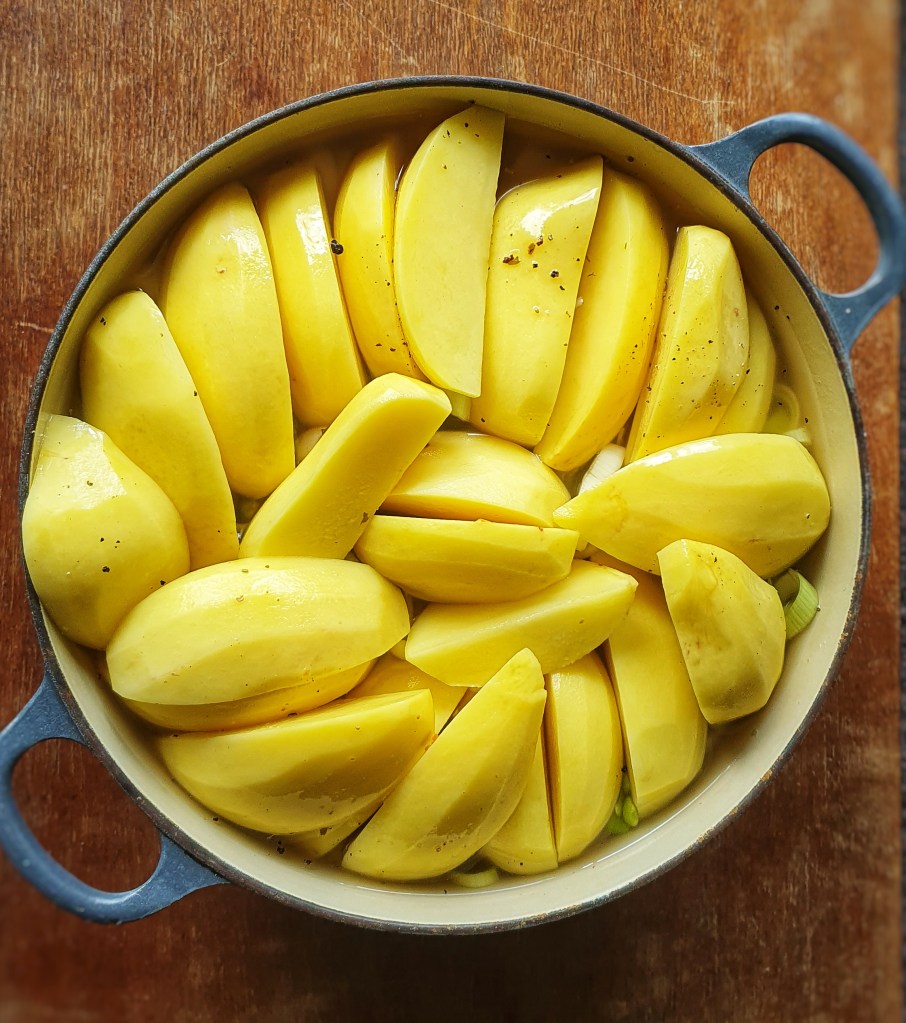
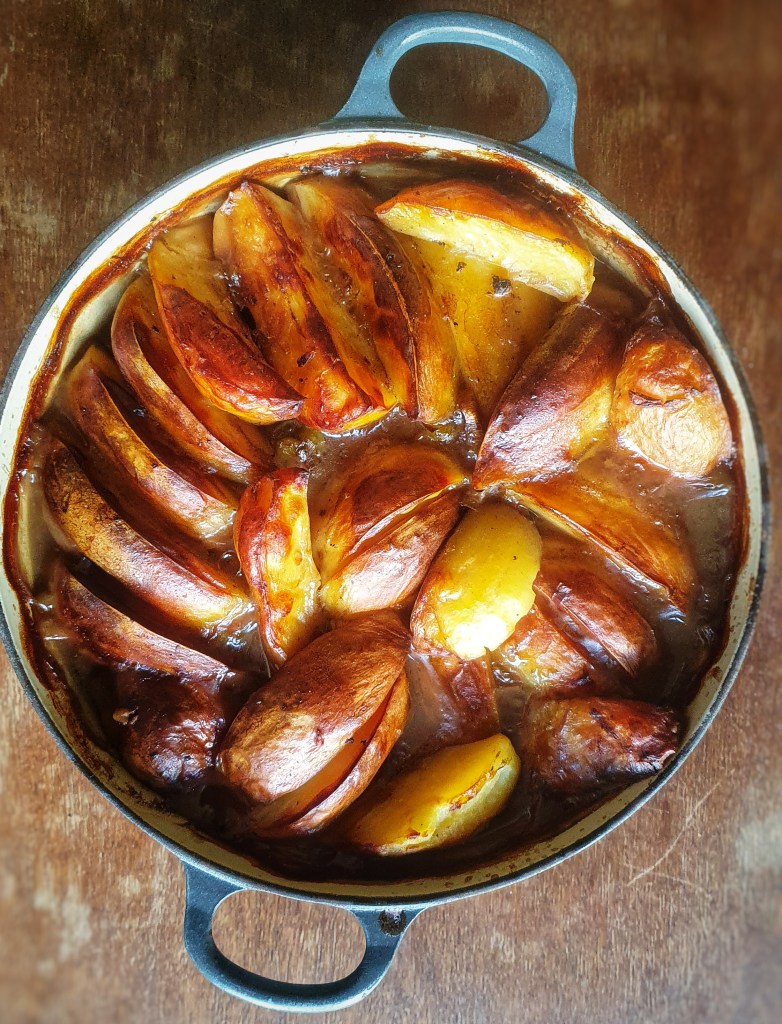
Jane was given the recipe from a Mrs Burrows, and in English Food, she tells us that ‘Mrs Burrows said that what interested her was that the tatie pot is one of our few dishes in which different meats are combined, something which is common in mainland Europe.’ Indeed, and assuming your black pudding contains pigs’ blood, then we have three species of mammal altogether; very rare indeed!
Jane Grigson points out that some recipes say that the beef is optional, ‘which it most definitely is not’, she writes, ‘[i]t makes the character of the dish.’ Looking at similar Lakeland recipes available on the Foods of England Project website, there are recipes that contain beef but not lamb (Westmorland tatie pot), and lamb but not beef (Cumberland hotpot). Neither contain pulses, and both have sliced potatoes nicely arranged on top like a Lancashire hotpot.[4] I’m not saying that Jane’s is right and others wrong; it is just interesting to me that everyone has their own correct version of a dish, possibly with slight geographical differences, and usually it’s the one you grew up with, the one that is most familiar to you, that is the ‘right’ one.
If you can, support the podcast and blogs by becoming a £3 monthly subscriber, and unlock lots of premium content, including bonus blog posts and recipes, access to the easter eggs and the secret podcast, or treat me to a one-off virtual pint or coffee: click here.
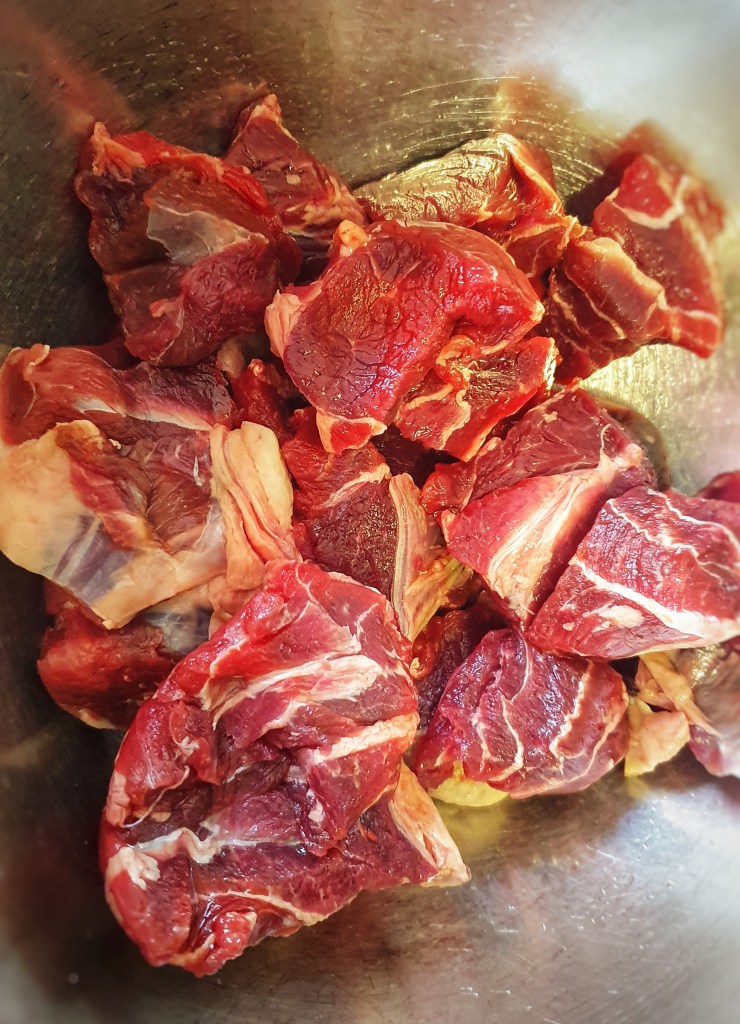

Recipe
The long cook time on this hotpot means that you need to keep the liquid levels topped up. You can use stock or water for this – there is nothing wrong with the latter when cooking with these robust cuts of meat.
Serves 8
4 tbs dried split peas or mixed pulses
750 g shin of beef
750 g lamb neck (‘scrag end’ of neck)
1 level tablespoon of cornflour
Salt and pepper
One 350 g Fruit Pig black pudding
2 onions, peeled and sliced, or 2 leeks, trimmed, rinsed and thinly sliced
Around 1.2 kg floury potatoes
Around 800 ml hot light beef, lamb, or chicken stock, or water
Soak the pulses in water overnight (or, if you are badly organised, soak in warm water for 4 or 5 hours).
Preheat your oven to 160°C. Shake the meat, cut into neat chunks, with the cornflour, and scatter the pieces over the base of a large casserole, season with salt and pepper, then tuck in slices of the black pudding. Sprinkle with the onions or leeks and the drained pulses. Peel the potatoes and slice them into quarters lengthways. Arrange the quarters on top; I find it is impossible to do this neatly. Pour over enough stock to go halfway up the potatoes and season them with more salt and pepper.
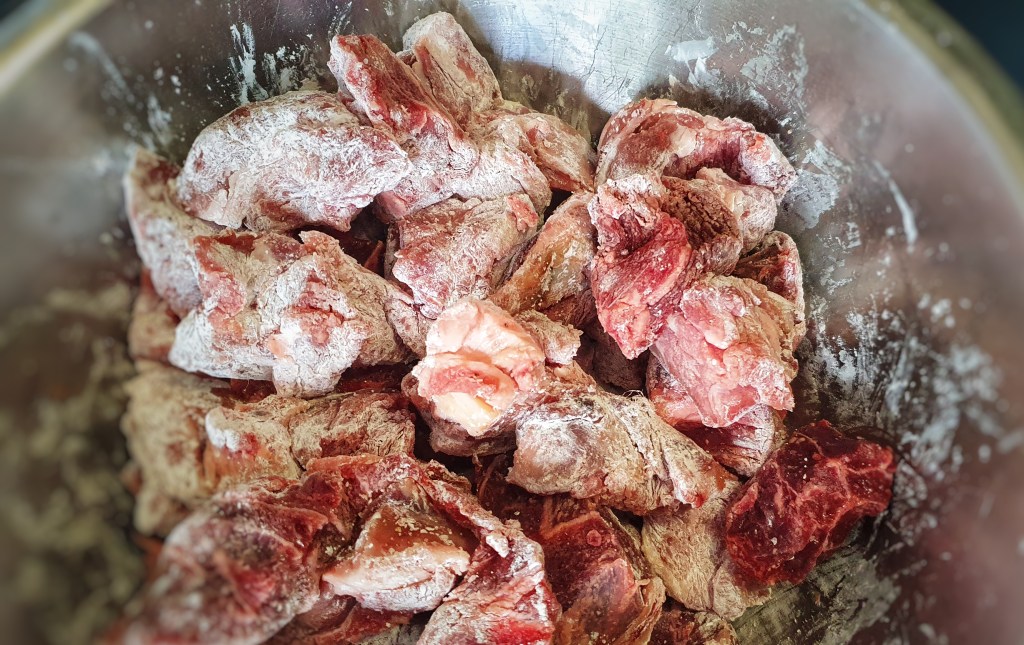
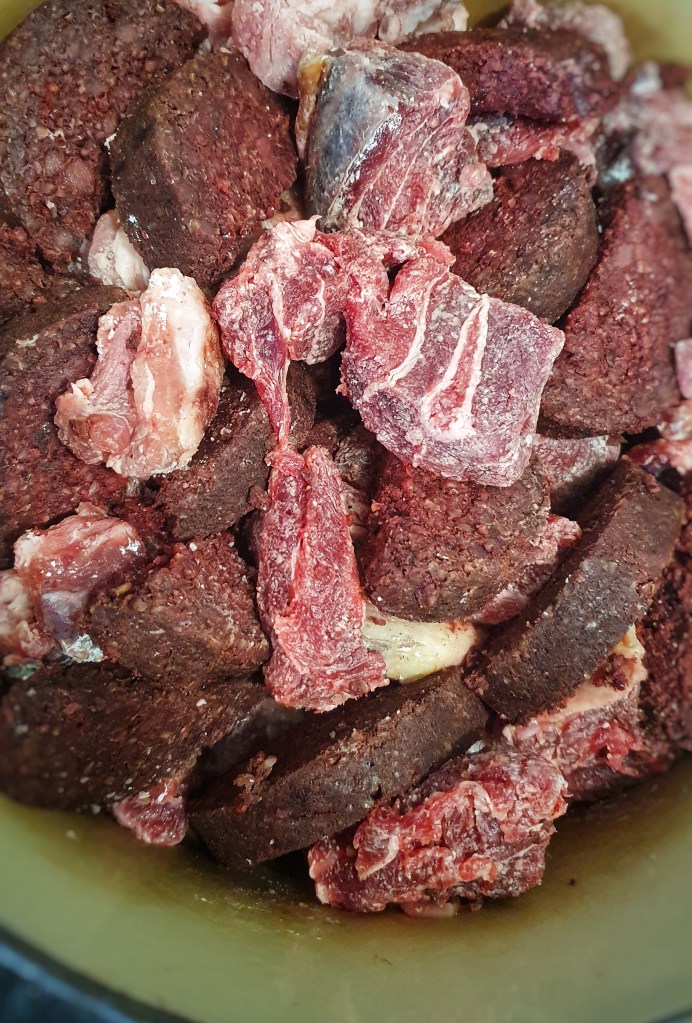
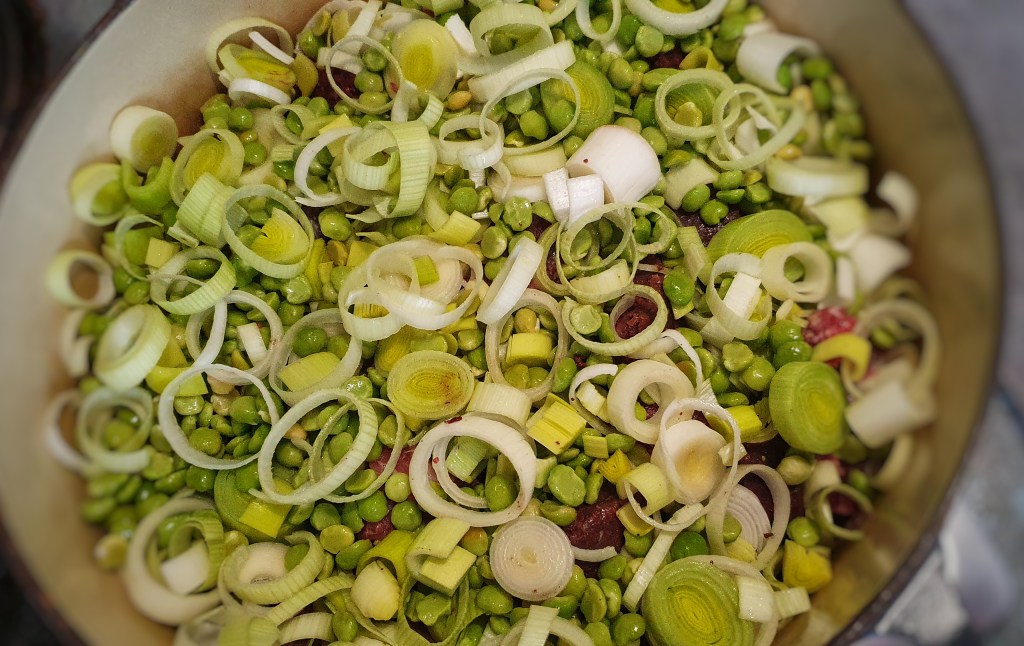
Bake for 4 hours, topping up with more stock or water every hour or so.
Serve with steamed green vegetables or braised red cabbage.
Notes:
[1] Grigson, J. (1992). English Food (Third Edit). Penguin.
[2] The Buttery was my bricks-and-mortar restaurant in Levenshulme, Manchester, open between 2016 and 2017, though it did exist as a pop up restaurant and artisan market stall before that.
[3] For those not in the know, I got into this traditional cookery and food history malarky because I cooked every recipe (well, almost every recipe) in Jane’s wonderful book. This was my first blog Neil Cooks Grigson. Hear about it in this podcast episode from season 8:
[4] Hughes, G. Tatie Pot. The Foods of England Project; https://foodsofengland.info/tatiepotorcumberlandhotpot.html.
Black & White Pudding with Matthew Cockin & Grant Harper
Welcome to the first episode of season 9 of The British Food History Podcast! I am going to be adding a blog post to complement each new episode of the podcast, to help readers of the blog keep tabs on what is going on.
Today I am talking with Matthew Cockin and Grant Harper of Fruit Pig – the last remaining commercial craft producer of fresh blood black puddings in the UK.
Fruit Pig are sponsoring the 9th season of the podcast and Grant and Matthew are very kindly giving listeners to the podcast a unique special offer 10% off your order until the end of October 2025 – use the offer code Foodhis in the checkout at their online shop, www.fruitpig.co.uk.
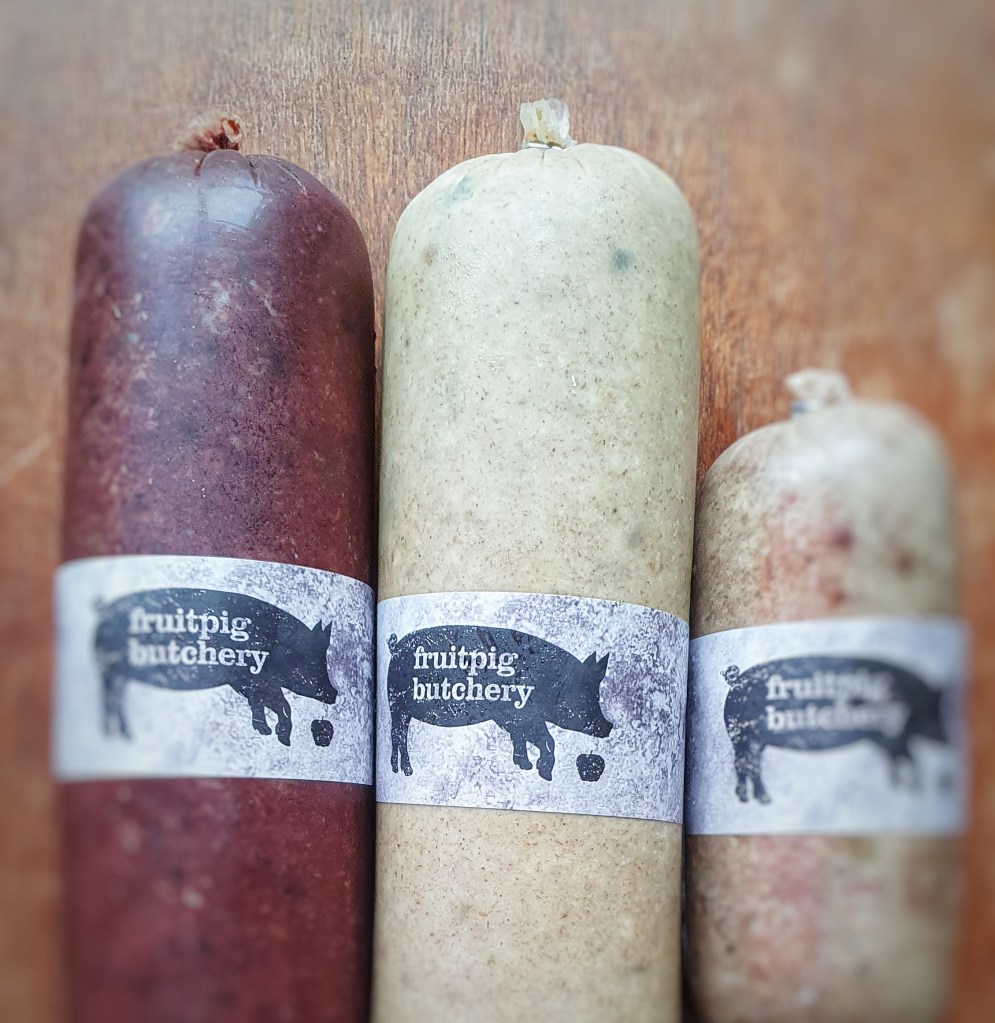
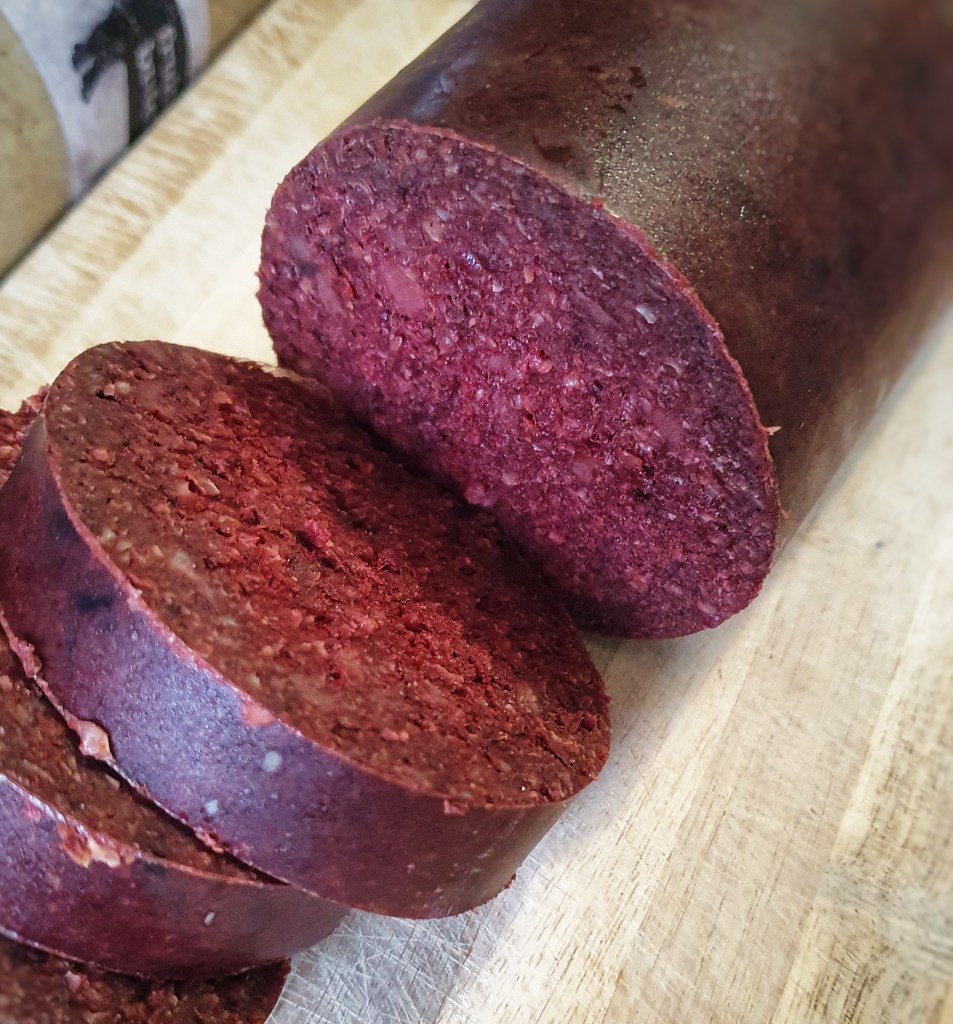
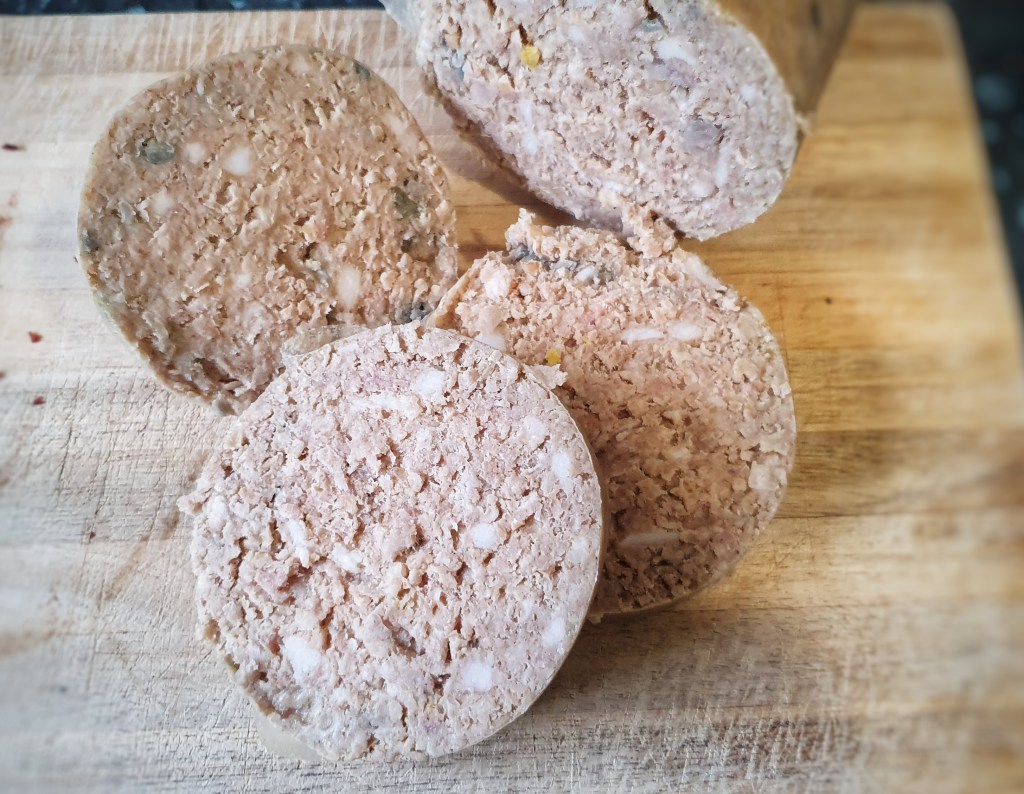
We talk about how and why they started up Fruit Pig, battling squeamishness, why it’s so difficult to make fresh blood black puddings, and serving suggestions – amongst many other things
The podcast is available on all podcast apps, aandd now YouTube. Please give it a follow, and if you can, please rate and review. If you’re not a podcasty person, you can listen via this Spotify imbed:
Some serving suggestions
One other thing we talked about was serving suggestions, and of course a slice or two of black and white pudding as part of a full English breakfast is admirable. You can go one better and have the full triple of black pud, white and haggis for a full Scottish! Personally, I believe a slice of fried bread topped with a couple of slices of fried pudding and a poached egg is the breakfast of champions.
These puddings are not just for breakfast, though. In Lancashire, a favourite way of eating black pudding is to poach it again, remove it from the water, drain, split lengthways and spread it with mustard. I have eaten it this way when visiting Bury Market. But my favourite way of eating black and white pudding in a simple way, is to serve fried slices of pudding with mashed potatoes and apple sauce – hot or cold, not too sweet. Here’s how to make a good ‘savoury’ apple sauce:
Peel, core and slice 2 medium-sized Bramley apples, and 2 tart dessert apples (e.g. Cox’s Orange Pippin) and fry in a saucepan with 60 g salted butter and a good few grinds of pepper. When the Bramleys start to soften, add 2 level tablespoons of sugar and 4 or 5 tablespoons of water. Cover and cook on medium heat, stirring occasionally, until the apples are cooked through and the Bramleys have broken down to a puree. Taste and correct seasoning. You need something still very tart to cut through the rich puddings.
Keep a lookout for a proper recipe and some of my experiments with the fresh blood, Matthew and Grant kindly sent me.
If you can, support the podcast and blogs by becoming a £3 monthly subscriber, and unlock lots of premium content, including bonus blog posts and recipes, access to the easter eggs and the secret podcast, or treat me to a one-off virtual pint or coffee: click here.
This episode was mixed and engineered by Thomas Ntinas of the Delicious Legacy podcast.
Things mentioned in today’s episode
Fruit Pig on Jamie & Jimmy’s Friday Night Feast
Fruit Pig on BBC Radio 4’s The Food Programme
Neil’s appearance on Comfortably Hungry discussing black/blood pudding
Museum of Royal Worcester project wins a British Library Food Season Award
Follow Serve it Forth on Instagram at @serveitforthfest
Podcast episodes pertinent to today’s episode
The Philosophy of Puddings with Neil Buttery, Peter Gilchrist & Lindsay Middleton:
18th Century Female Cookery Writers with The Delicious Legacy:
Neil’s books:
Before Mrs Beeton: Elizabeth Raffald, England’s Most Influential Housekeeper
Knead to Know: a History of Baking
Don’t forget, there will be postbag episodes in the future, so if you have any questions or queries about today’s episode, or indeed any episode, or have a question about the history of British food please email me at neil@britishfoodhistory.com, or leave a comment below.
Roast Turkey and Giblet Gravy
This blog post complements the recent episode of The British Food History Podcast called Turkey with Tom Copas.
If you feel inspired to order a Copas turkey, you need to get your order in by 16 December to avoid disappointment.
In the episode, we discussed the best way to roast turkey and we concluded that as long as you baste the bird and calculate the cooking time properly, it will be delicious. Tom even says that there’s no need to cover the turkey with bacon. While I agree with him, I do like the crispy bacon and the delicious, perfectly seasoned juices that come from the roasting turkey. My way of roasting turkey is very similar to how I cook a chicken.
What we didn’t discuss is the giblets! Please don’t waste them, they can be turned into lovely rich gravy when combined with the roasting juices. It’s important to get the giblet stock on about 45 minutes before the turkey goes in the oven (or you could prepare it in advance).
If you want to stuff the turkey, I suggest you stuff the neck only because an empty cavity means quicker cooking and a more succulent turkey.
Right, let’s get to it.
If you like the blogs and podcast I produce and would to start a £3 monthly subscription, or would like to treat me to virtual coffee or pint: follow this link for more information. Thank you.
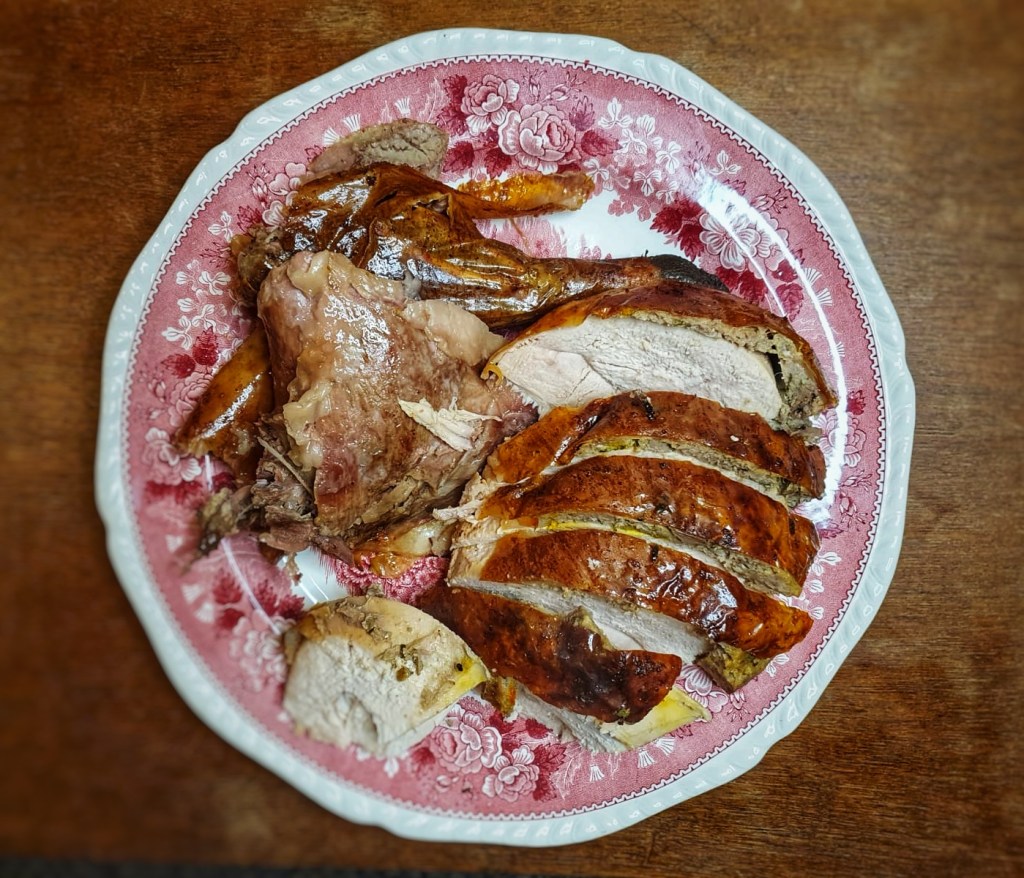

To Roast a Turkey
You don’t have to use bacon if you don’t want to, but butter is essential. It adds richness, helps the bird keep moist and gives the skin a lovely deep brown colour.
1 free-range turkey
250 g salted butter, softened
Freshly ground black pepper
Around 14 rashers of dry-cured streaky bacon (optional)
Stuffing (optional)
Halved or quartered carrots and parsnips (optional; see recipe)
As soon as you get up on Christmas morning, take the turkey out of the fridge, untruss it, and when it’s time to cook the turkey, preheat your oven to 190°C.
Sit the turkey on a board, legs facing towards you, then make a tear in the skin where the breast starts and lift the skin away from the breast. Don’t rush – you don’t want to tear the skin. Put half the butter between the skin and breast and massage it as far back as possible. If you are using stuffing, add this under the skin too and tuck the flap of neck skin underneath. If there’s not much neck skin, don’t worry, it can be secured with a skewer.
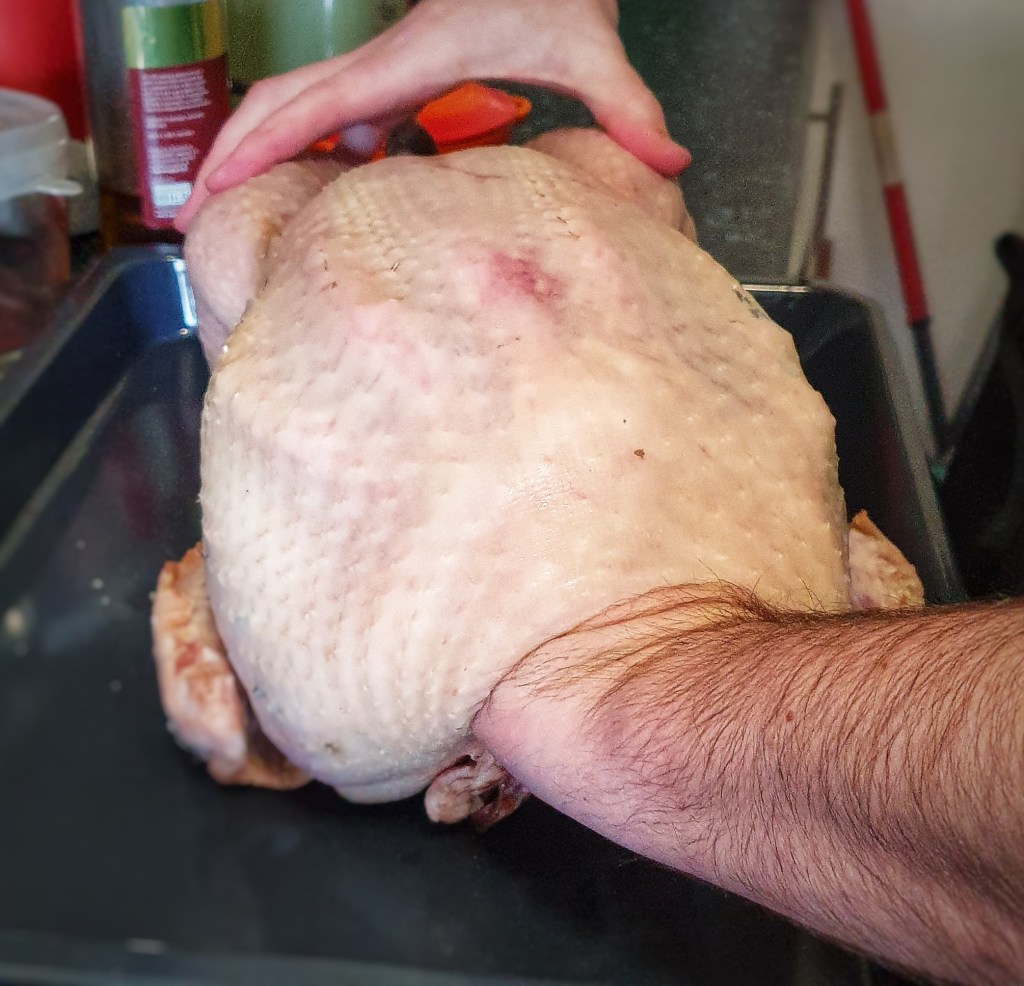
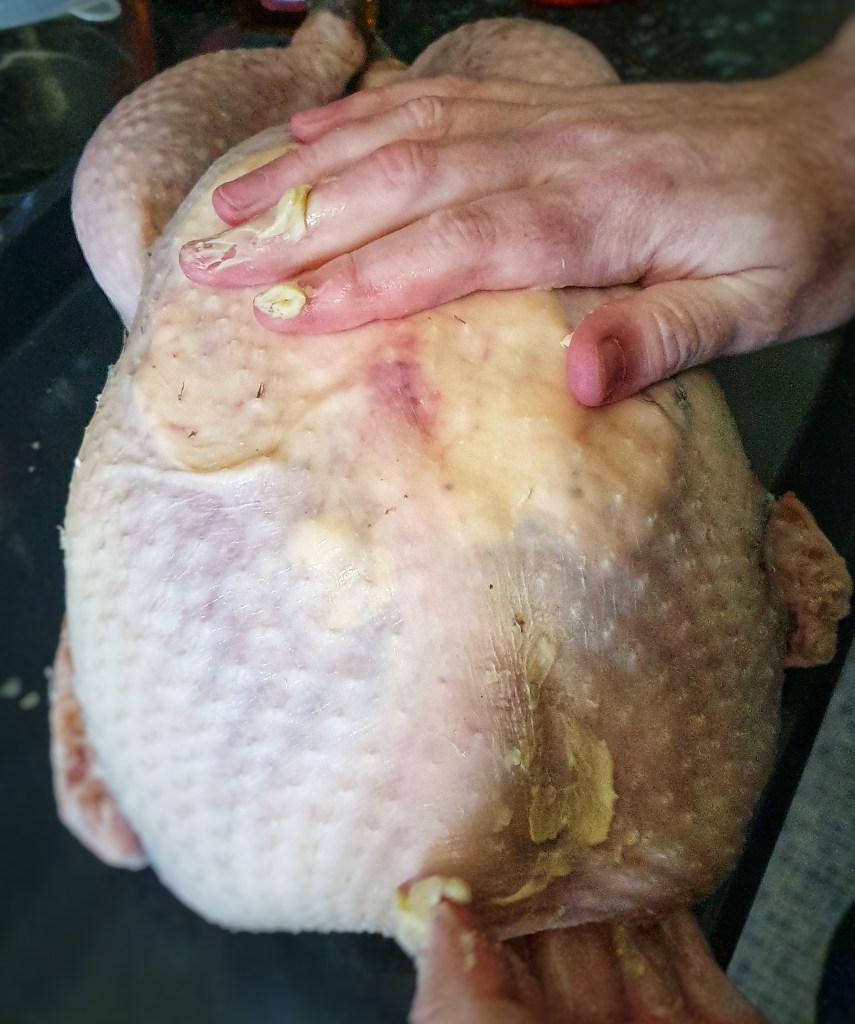
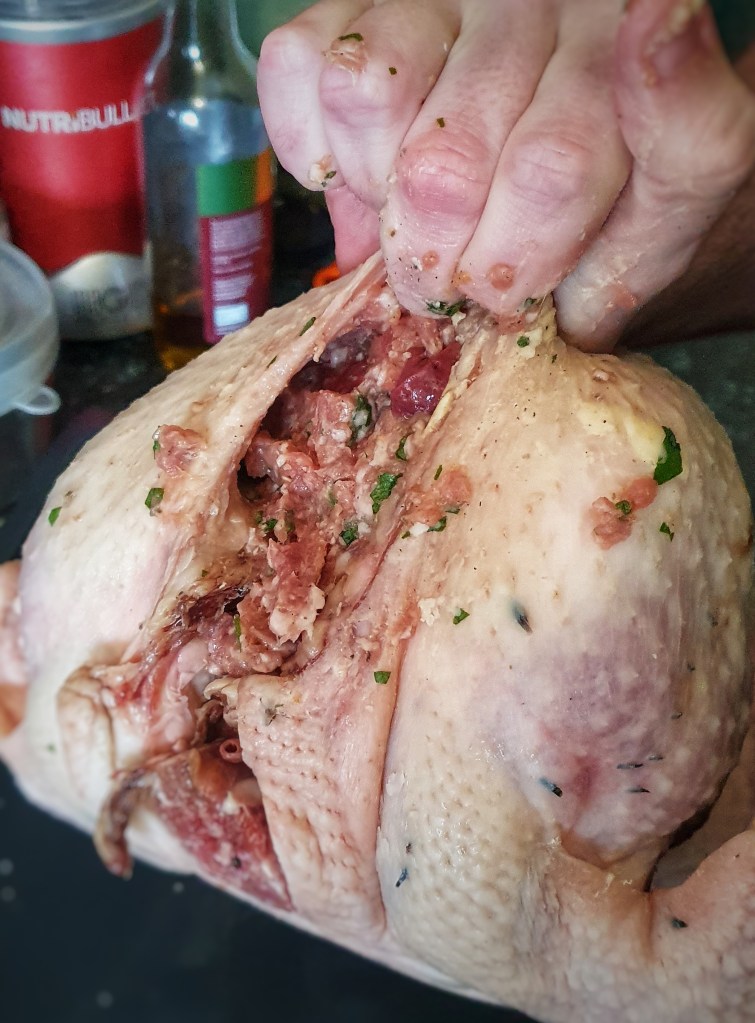
Smear the rest of the butter over the outside of the turkey and season with plenty of black pepper, then lay the bacon over, overlapping each rasher only slightly.

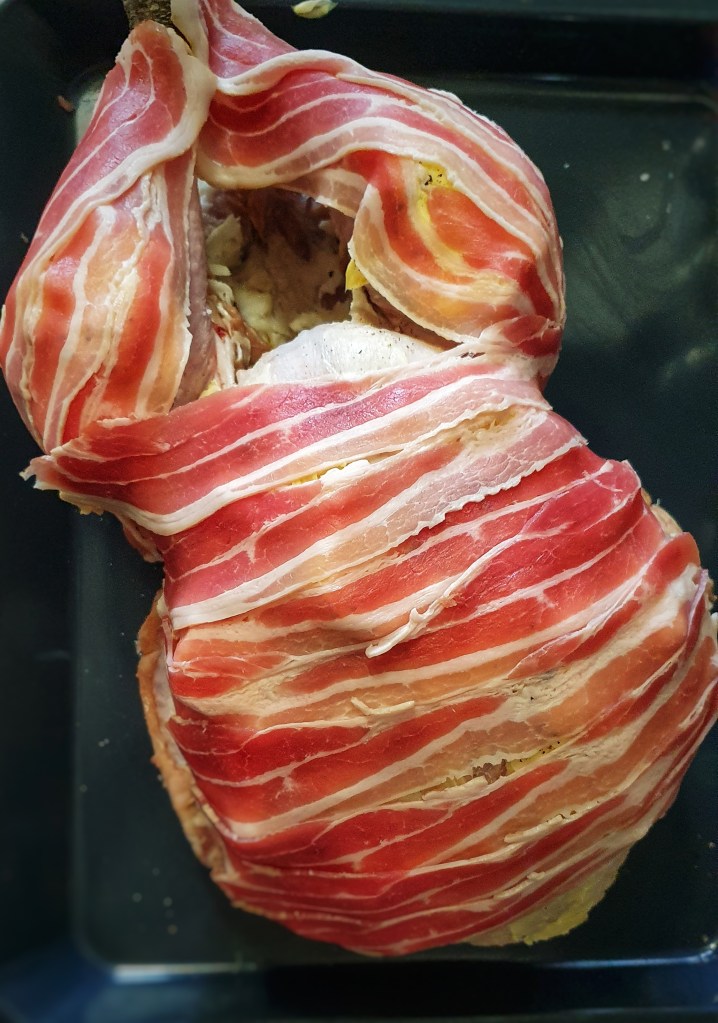
Weigh the prepared turkey and calculate the cooking time: 30 minutes per kilo. A 4.5 kilo turkey will take 2 ½ hours. If cooking for more than 3 hours, cover the legs with foil.
Sit the turkey in its roasting tin, place it in the oven, and leave it for a good 45 minutes before doing anything at all. At the 45-minute mark baste the turkey with any juices; make sure to tip any juices in the cavity into the roasting tin.
Baste every 20 minutes or so. When the bacon is very crispy, remove it and set aside.
If you like you can add some carrots and parsnips, peeled and halved or quartered to braise in the juices. It’s best to do this when there are 90 minutes to go – don’t forget to turn the veg over each time you braise.
When the time is up, you can test with a digital probe: 68°C is the temperature you are looking for. Take the turkey, place it on a carving board and cover with foil. It will happily rest for one to two hours.
When it’s time to carve, remove the legs and separate them into thighs and drumsticks. For the breast, I find the easiest way is to remove one side completely and then slice it thickly. These can be arranged on a warm serving plate, surrounded by the crisp bacon. Only cut into the second breast if the first one goes (it keeps better that way for leftover feasts).

To Make Giblet Gravy
Don’t waste or fear the giblets! The giblets are the heart, neck, gizzard and liver.[1] Use your vegetable trimmings from the veg to make the stock: though avoid brassicas like sprouts.
For the stock:
Heart, gizzard and neck
A knob of butter
Leek greens, carrot peelings, and some celery trimmings, or 2 outer stems of celery
2 cloves of garlic, lightly crushed
Herbs: bay leaves, parsley stalks, rosemary or thyme sprig tied with string
175 ml white wine
Cold water
For the gravy
Giblet stock
Pan of turkey juices
1 tbs cornflour
To make the stock, first cut up the giblets into quarters.
In a saucepan, heat the butter until foaming, add the giblets and fry over a medium-high heat until brown – about 5 minutes. Now add the vegetable trimmings, garlic and herbs and wilt them. Cook until they have picked up a tinge of brown, then add the wine. Stir and scrape any nice burnt bits from the bottom. Add water to just cover the contents, put a lid on and bring to a simmer and cook for around 3 hours, then strain through a sieve into a clean pan (or into a tub if you’re making it in advance).
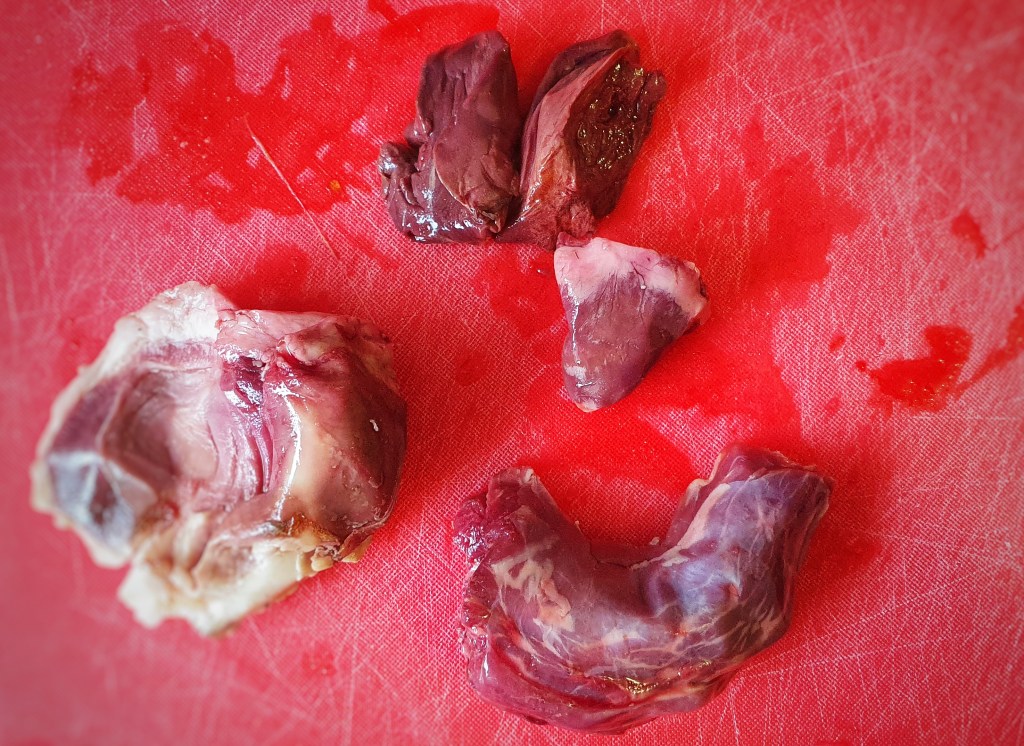
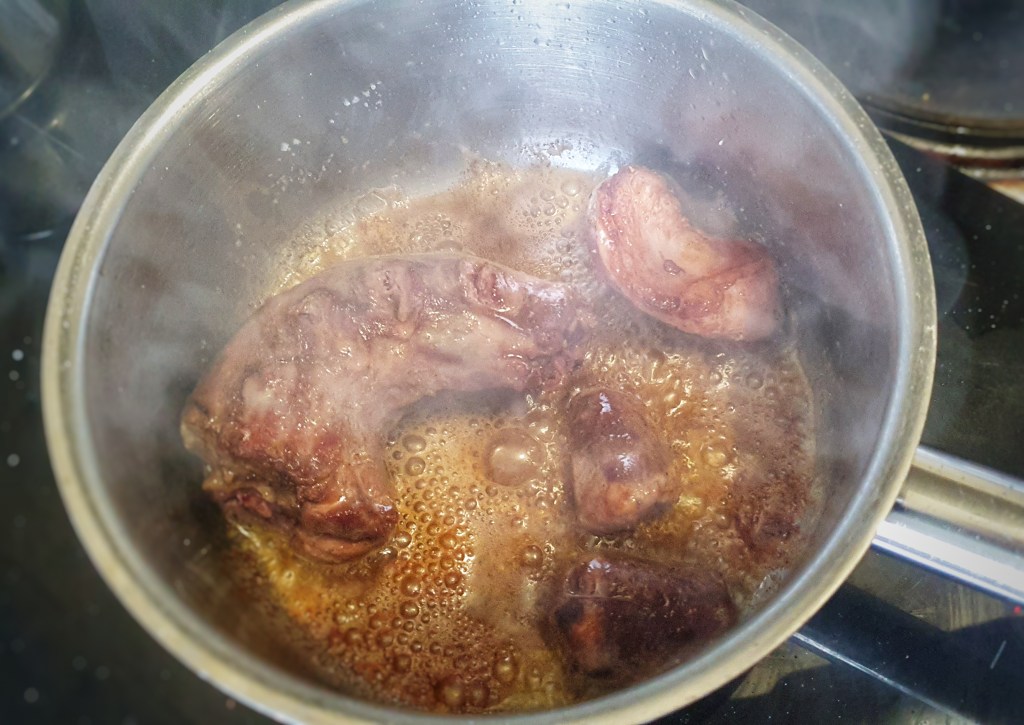

When it’s time to make the gravy, get the stock nice and hot. When the turkey is cooked and is resting on its board, pour the hot stock into the roasting tin and scrape off all the nice treacly burnt bits, then tip the whole thing back into your saucepan. Skim away most of the buttery juices.[2] Bring to a simmer and then add the cornflour which has been first slaked in a little cold water. Stir and simmer unlidded for 10 minutes.
Check the seasoning, though usually I find that the bacon and the salted butter from roasting the turkey have done it for me. Pour the gravy into a jug. You can pass it through a sieve, but I never do. Easy!
[1] Use the liver for the stuffing, or fry it and eat it on toast. You could devil it – recipe for devilling livers can be found here.
[2] But don’t throw the fat away, it can be used for frying vegetables for sauces or soup.
To Roast a Haunch of Venison
Christmas isn’t too far away and the chances are you are probably already discussing what meats you will be roasting on the big day. Well, I am going to stick my neck out and suggest venison. Game used to be a very important part of the Christmas feasting, especially in the countryside, making an excellent centrepiece to the day’s feasting.
Regular readers will know that I love cooking with game, but it has been a while since I cooked some up for the blog. I got the opportunity to cook a nice haunch of venison because I was sent some from Farm Wilder to try out, and my gosh it was good. Apart from the meat being tender and delicious, the deer that make their venison are culled as an important part of land management in Southwest England. Without any natural predators, their numbers are increasing and pretty as they may be, they are very damaging to woodland habitats – in short, they are a menace![1]
For more information about Farm Wilder and their venison, click this link.
The important thing when buying a roasting joint is to buy as large a one as possible; large joints always roast juicier and more evenly. Bear in mind that any excess venison can be chopped and made into a hunter’s pie – essentially a shepherd’s pie but with lamb swapped for venison. I’ve suggested a 2 kg haunch but don’t worry if yours is a different weight, I have included a formula for calculating the roasting time in the method. The haunch is the equivalent of beef topside, but I think it is a much superior joint in both tenderness and flavour.
Venison is best marinated before cooking; it adds a complexity of flavour to the meat and makes it even more tender. Many recipes go into great detail about how this should be done using cooked marinades, but I think the best is also the simplest: red wine, red wine vinegar, olive oil and some herbs and spices.
Folk also make a big deal about the meat drying out in cooking (venison being a very lean meat) and there are – again – complex methods to keep the meat moist: larding it with needles or tying sheets of pork backfat or skin around it. These work, but I have found that smearing the joint with plenty of butter and covering it all with smoked streaky bacon works perfectly, adding more depth of flavour; and you get to eat some crispy bacon with your dinner.
I chose to serve my venison with potatoes and parsnips roasted in duck fat, Brussels sprouts, gravy and a fruit jelly: redcurrant is the easiest to get hold of from the shops, but quince or medlar jelly can be used too.
Serves 8:
2 kg haunch of venison
½ bottle red wine
125 ml red wine vinegar
125 ml olive oil
Around one dozen black peppercorns and juniper berries
A bunch of herbs: e.g., rosemary, thyme, marjoram or winter savoury sprigs, 3 or 4 fresh bay leaves
2 carrots, peeled and sliced
2 sticks celery, trimmed and sliced
1 leek or onion, trimmed and sliced
75 g salted butter, softened
Salt and pepper
6 to 8 rashers of smoked streaky bacon
2 tbs of redcurrant, quince or medlar jelly
2 or 3 tsp cornflour
500 ml beef stock
The day before you want to cook the venison, place it in a tub only slightly larger than the joint itself along with the wine, vinegar and olive oil. Lightly crush the spices, tie the herbs with some string and add those too. Make sure the venison is covered – or mostly covered – by the wine mixture then cover and refrigerate. Turn the meat once or twice if it is not completely submerged.
Next day, take the tub out of the fridge a few hours before you want to cook the meat, so it can come up to room temperature. Preheat your oven to 225°C. Calculate your cooking time: for rare meat roast for 15 mins per 500 g of meat plus 15 minutes; for medium 18 mins per 500 g plus 15 minutes.[2]
Now prepare the meat. Spread your vegetables in the centre of the tray and place the venison on top. Dab it dry with some kitchen paper then smear the top with the butter, season well with salt and pepper, then cover the top with the bacon, making sure each rasher overlaps the next slightly.
Ladle around half of the marinade into the tin and slide the meat into the oven. Roast for 15 minutes and then turn the heat down to 180°C. Baste the venison every 15 to 20 minutes or so, adding more marinade if it starts to dry up.
For the last 15 minutes of the cooking time, turn the heat back up to 225°C, remove the bacon, give the meat one more baste, and let it crisp up at the edges. Take the tin out, remove the meat to a board or dish and cover with kitchen foil. It will sit very happily there as you roast your potatoes and cook your veg.
Now make the gravy. Strain the contents of the tin into a jug and spoon or pour a couple of tablespoons (approximately) of the buttery olive oil layer into a saucepan. Discard the rest of the fat. Put the pan over a medium heat and stir in 2 teaspoons of cornflour. Once incorporated, cook for a minute before adding the juices. Mix to blend, before adding the beef stock, mix again and then add the remaining marinade. Cook for 10 minutes, then add the jelly and season with salt and pepper. If the gravy isn’t as thick as you’d like, slake another teaspoon of cornflour in a little cold water and stir it in. When ready, strain into a warm jug.
Remove the outer mesh covering the joint, slice and serve with the gravy, the crisp bacon rashers and extra jelly on the side.
If you like the blogs and podcast I produce and would to start a £3 monthly subscription, or would like to treat me to virtual coffee or pint: follow this link for more information. Thank you.
Notes:
[1] It is for this reason that I consider venison a vegan-friendly food: we’d have to cull them whether we ate meat or not, so we may as well.
[2] If you like your meat well done, I can’t help you.
Sustainable Meat Cookery Part 1: Central Nervous System
This post complements the special podcast episode I made for my £3 monthly subscribers on the topic of sourcing and cooking the organs of the central vervous system – brain, spinal cord and eyes – a most taboo topic. Inside you will find the episode itself as well as my method to prepare brains for cooking as well as a few recipes – should you get your hands on any.
If you are not a subscriber, you can become one on the Support the Blogs and Podcast tab of the blog, where you will access all of my Easter eggs, premium blog content and receive my weekly newsletter AND help support the running of everything too!
Subscribe to get access
Read more of this content when you subscribe today.
Forgotten Foods #10: Porpoise

It seems almost inconceivable that the porpoise – a type of small dolphin – would ever have been eaten, but it was once a most high-status ingredient. Although it is obviously a mammal, in the Middle Ages it was considered a fish, and therefore it could be eaten on fast days (all of the cetaceans were ‘fish’ as were seals and beavers’ tails) and it was usually served on fish days as a substitute for venison, another very high-status meat.[1] It seems that this was a bit of a blip for Europe: for the last few centuries, as well as in antiquity, dolphins have been very much considered a ‘friend of man’, and not an animal that should be eaten, not so in the Middle Ages.[2] The word porpoise comes from the Old French words porcus and piscus: ‘pigfish’ They have also gone by the names ‘mere-swine’ and ‘seahog’[3] and were eaten at the poshest of posh feasts. When George Neville celebrated becoming Archbishop of York in 1466, he held a huge feast, inviting 2000 guests of very high rank, the fish course was made up of 608 bream and pike, and 12 porpoise and seal.[4]
There were several ways of preparing it; if fresh it was poached and served in slices. In the late 14th century manuscript Forme of Cury, it is served with frumenty.[5] Sometimes it was cooked in a broth with wine, vinegar, bread, onions and its own blood.[6] It was also salted and cooked with dried peas and beans, rather like salt pork. If tip-top fresh, ‘porpesses must be baked’. The carving term for a baked porpoise is ‘undertraunche’[7], and it is served dressed with vinegar, cinnamon and ginger.[8]
The earliest mention of a porpoise hunt occurring in the British Isles comes from the 7th century just off the Irish coast by ‘foreigners’ most probably Vikings. The 10th century manuscript Ælfric’s Colloquy does mention the hunting of dolphins[9] and when we tick into the 11th century – during the reign of Æthelred II (the Unready) – there are rolls listing fisheries in Gloucester which specialised in fishing for them. Just one porpoise is mentioned in the Domesday Book – it was paid as geld at an estate in Kent. Post-conquest, they appear more frequently in ordinances for example: 10 people were supplied for Henry III in 1256 at the Feast of St. Edward – a feast that always occurs during Lent.[10]

Kongelige Bibliotek, Gl. kgl. S. 1633 4º, Folio 60v)
One does have to wonder how much luck was needed when it came to ‘hunting’ them because the majority of them seem to have been opportunistically acquired after the poor beasts were found beached. One, therefore, also has to wonder just how fresh these porpoises were when delivered to a noble’s kitchen. I suspect that they were very quickly salted down and stored until there were ordered. There were laws laid down as to who owned the poor creatures after they were found beached; for most of the Middle Ages they were considered ‘wrecks of the sea’, so it was a case of finders’ keepers, but in the 13th and 14th centuries – the period when eating porpoises reached its peak – it was asserted that all beached porpoises belonged to the Crown.[11]
The number of porpoises consumed really drops in the Early Modern Era: Henry VIII was gifted a porpoise at Calais in 1532, and in 1575 (during the reign of Elizabeth I) one appeared for sale at Newcastle Market. After that, mentions of porpoises as food seem to dry up.[12]
If you are a historical cook, you might be wondering what you could substitute if you wanted to recreate a dish containing porpoise for a medieval menu. Historian Peter Brears has one fine suggestion: use a large piece of the freshest, firmest and largest block of tuna you can afford![13]
If you like the blogs and podcast I produce and would to start a £3 monthly subscription, or would like to treat me to virtual coffee or pint: follow this link for more information. Thank you.
[1] Brears, P. (2012). Cooking & Dining in Medieval England. Prospect Books.
[2] Davidson, A. (1999). The Oxford Companion to Food. Oxford University Press.
[3] Gardiner, M. (1997). The Exploitation of Sea-Mammals in Medieval England: Bones and their Social Context. Archaeological Journal, 154(1). https://doi.org/10.1080/00665983.1997.11078787; The Shuttleworth Family. (1858). The House and Farm Accounts of the Shuttleworths of Gawthorpe Hall, in the County of Lancaster, at Smithils and Gawthorpe From September 1582 to October 1621 · Part 4 (J. Harland, Ed.). The Chetham Society.
[4] Brears (2012)
[5] Frumenty: a whole wheat ‘risotto’, ‘messe it with porpays’, says Forme of Cury.
[6] Hieatt, C. B., & Butler, S. (1985). Curye on Inglysch: English culinary manuscripts of the fourteenth century. Oxford University Press.
[7] In the Middle Ages each animal served at table had its own carving term: so one doesn’t carve a porpoise, one ‘undertraunches’ it.
[8] Brears (2012); Furnivall, F. J. (1931). Early English Meals and Manners. Forgotten Books.
[9] It also states that whales should not be hunted: far too dangerous. Read a translation online here: https://pdf4pro.com/amp/view/aelfric-s-colloquy-translated-from-the-latin-by-2a9241.html
[10] Gardiner (1997)
[11] Ibid.
[12] The Shuttleworth Family (1858)
[13] Brears (2012)
Braised Shoulder of Mutton
This post has been written in a collaboration with Swaledale Online Butchers, ‘a strictly whole-carcass, nose-to-tail butchers based in Yorkshire.’ Their meat is of the highest quality, and they supply to some of the best restaurants in the country.
Braised shoulder of mutton is an iconic British dish, though I wonder how many of us has ever tried it. That it was such a part of our food culture is reflected in the fact that it is a very popular pub name. The shoulder is made up of several muscles, all of which work hard, so slow cooking is essential. Braising is by far the best way to cook it: the meat sat in the cooking liquid goes wonderfully tender whilst the rest of the meat roasts and the skin goes crisp.
Mutton and lamb go very well with anchovy, and I’ve chosen to roast my mutton spread with Gentleman’s Relish, the spiced potted anchovy spread. If you can’t get hold of it, don’t worry, you can make some yourself, or simply mash some canned anchovies with a few spices.
The shoulder takes 6 hours to cook, but don’t let that put you off; for the vast majority of the time, you don’t need to do anything at all!
Serves 8
2 leeks or red onions, sliced
4 good sized cloves of garlic, crushed with the flat of a knife
8 sprigs or rosemary, marjoram or oregano
1 shoulder of mutton, on the bone
Salt and pepper
20g (half a tub) Gentleman’s Relish or ½ can of anchovies and ½ tsp each nutmeg, mace and cayenne pepper
125g butter, softened
500ml red wine
250 ml beef or mutton/lamb stock
2 level tsp cornflour
1 tsp brown sugar or 1 tbs redcurrant jelly
Preheat your oven to 120°C.
Strew the leek or onion, garlic and herbs over the base of roasting tin large enough to fit your mutton.
On a board, season the underside of the meat, then place in the tin, skin side up. If using Gentleman’s relish, spread it over the skin of the mutton, then spread the butter on top of it. If using anchovies, simply mash them with some of the softened butter with the spices.
Season again with salt and pepper – though hold back a little on the salt if you have used Gentleman’s Relish – and pour the stock and red wine over the lamb. Cover with foil and braise in the oven for 5 ½ hours.
Remove from the oven and turn up the temperature to 220°C, take off the foil and pour the majority of the cooking liquor into a saucepan. Be careful here – it’s easier to remove the mutton to a board, then pour the wine and stock, then pop the mutton back in the pan.
Return the mutton to the oven for 25 minutes to crisp up, basting it half way through the time. Remove, cover with foil and allow to rest.
Meanwhile, spoon off any fat from the liquid and place over a high heat to reduce by half. Slake the cornflour in a little cold water and whisk into the reducing gravy. Add the sugar or redcurrant jelly, taste and correct for seasoning. Add more sugar or jelly if required.
Take the meat from the bone and cut into thick slices and place on a warm serving dish and pour the gravy through a sieve into a gravy jug.
Serve with mashed potatoes, kale and carrots.
Mutton Chops
This post has been written in a collaboration with Swaledale Online Butchers, ‘a strictly whole-carcass, nose-to-tail butchers based in Yorkshire.’ Their meat is of the highest quality, and they supply to some of the best restaurants in the country.
I was contacted by Swaledale Butchers recently to write some traditional recipes using their excellent meat. Swaledale is an online butcher who share exactly the same ethos as I do: championing all cuts of meat, not just the prime ones, so when they asked me to choose a couple of items to cook at home, I jumped at the chance.
I decided to choose mutton, a meat that many folk think is tough and not worth eating. They couldn’t be more wrong! Eating mutton over lamb is no different to eating beef over veal. A longer life gives the meat more flavour, but it is certainly not tough. To prove my point I chose two very different cuts one requiring slow cooking, the other a quick cook: shoulder and chops. I’ll deal with the shoulder in a future post soon. Today it’s all about tender mutton chops.
Breaded Mutton Cutlets with Lemon Butter Sauce
Mutton chops were a very popular food, grilled or fried and served with a strong tasting sauce or gravy. Devilled mutton chops are very good – indeed if you fancy a go at that, I have an excellent devil sauce recipe here. My recipe for breaded chops couldn’t be more different though; it’s an excellent summery dish that’s especially useful for people who, like me, don’t have a barbecue but really enjoy eating al fresco.
The chops may be breaded and fried, and the sauce somewhat buttery, but it’s surprisingly light; using chicken stock over beef or mutton stock, as one might usually expect. For the aromatics, I eschew rosemary and mint completely and go instead for zesty marjoram and grassy parsley.
Feel free to trim the chops into cutlets, but I always think you’re losing a lot of the meat, and these chops from Swaledale have such soft fat, it really would be a crime to cut it off. Because it is a rather quick cook, you may want to trim the small amount of rind, but it is really not a necessity.
Serves 2
80 g breadcrumbs made from stale bread (gluten-free bread works very well here, by the way)
Zest 1 lemon, grated
2 tsp finely chopped parsley
1 tsp finely chopped marjoram (oregano, thyme or savory are good substitutes)
Salt and pepper
4 mutton chops, cut around 1 ½ inches/4 cm thick.
1 egg, beaten
30 g lard or dripping
2 level tsp plain flour or corn flour
300 ml chicken stock
50 g butter, diced and chilled
A squeeze of lemon juice
Mix the breadcrumbs, lemon zest and herbs, season with salt and pepper and spread the mixture out onto a plate. Coat each chop in egg, then coat in the breadcrumbs, tapping away excess. Set aside.
Melt the lard or dripping in a heavy based frying pan over a medium heat. Once hot, add the chops. It’s important to leave them be for the first two or three minutes, lest you lose the breadcrumb coating. After four minutes turn them over and cook the other side, basting the chops every now and again. After 8 minutes they will be ready, remove and place on kitchen paper and put them in a warm oven to keep them crisp.
Now make the sauce. In the same frying pan, turn up the heat to medium-high (don’t worry about any dark brown breadcrumbs, we’ll deal with those soon) sprinkle the flour and stir with a wooden spoon so that the flour absorbs any stray fat, then pour in the stock by degrees, making sure there are few lumps. Bring to a boil and simmer for a couple of minutes to cook out the flour, then take off the heat and whisk in the cubed butter two or three cubes at a time. Add a squeeze of lemon juice. Taste and check for seasoning, adding more lemon, salt or pepper as required. Pass through a sieve and straight into a sauceboat.
Serve the cutlets and the sauce with steamed new potatoes, mushrooms fried in butter and a rocket salad.

